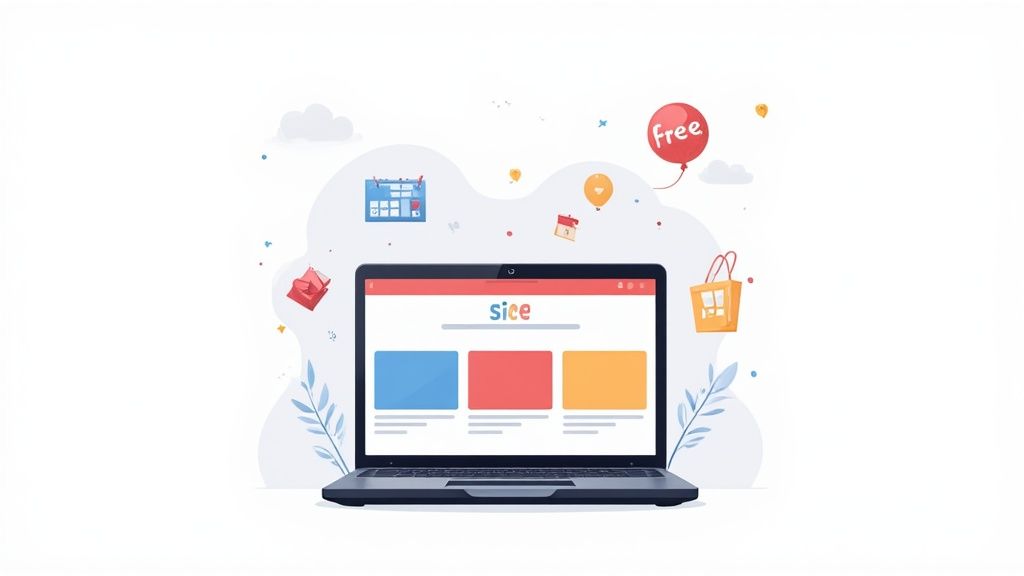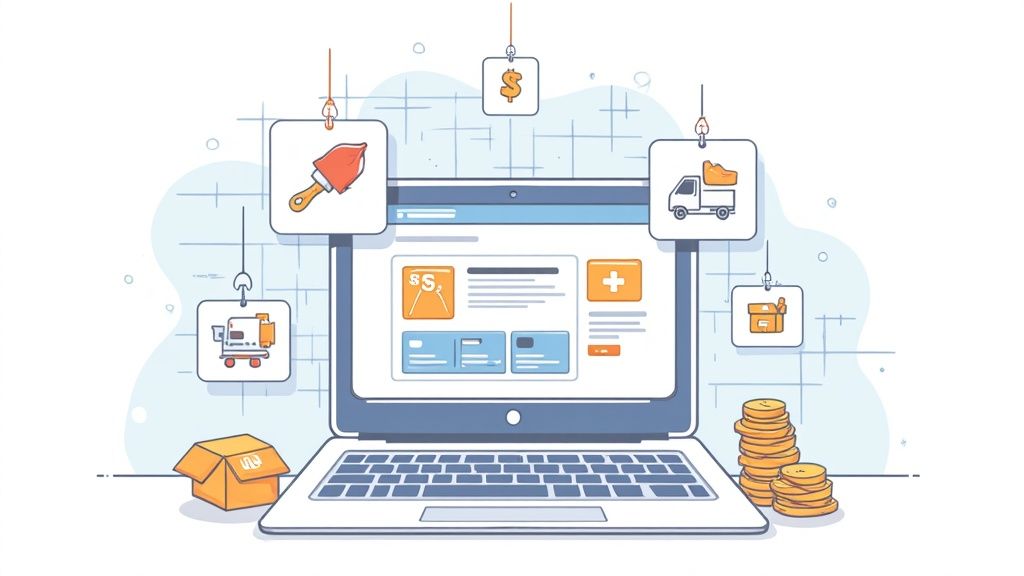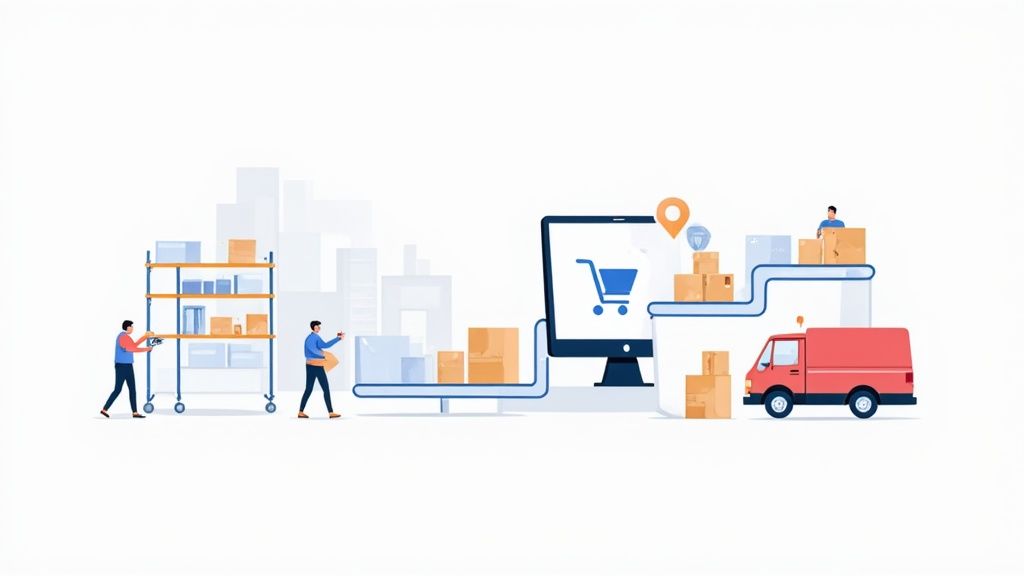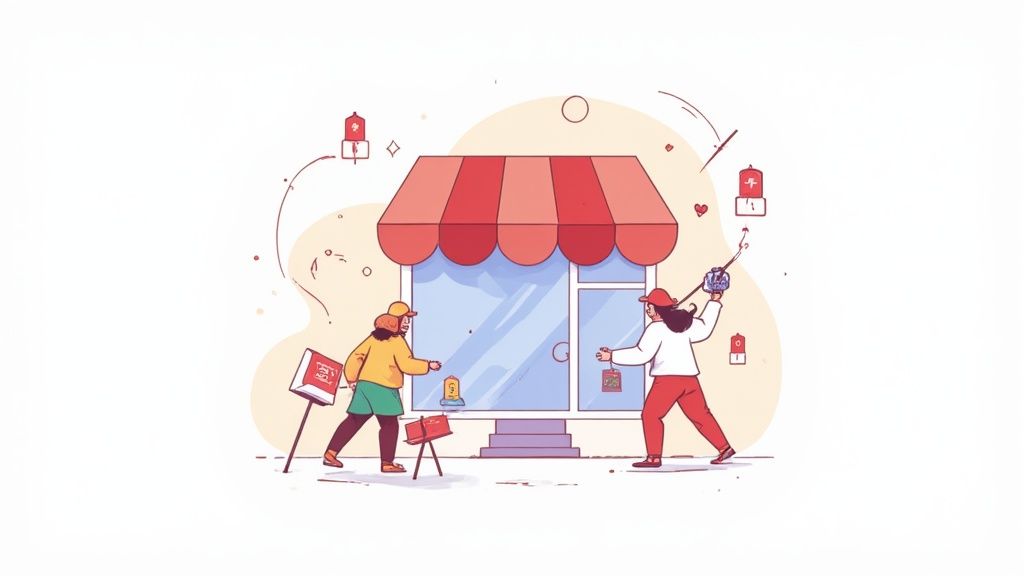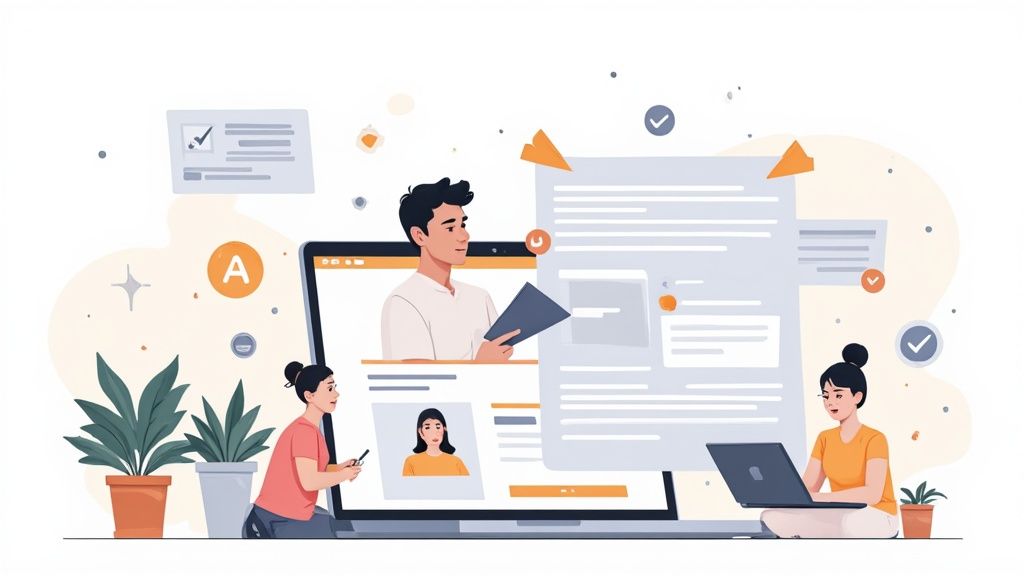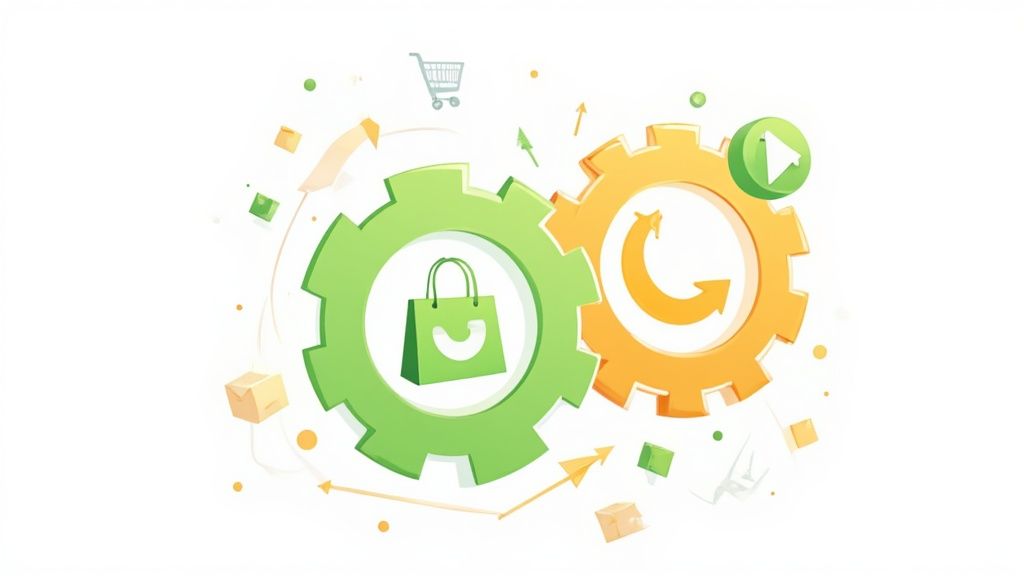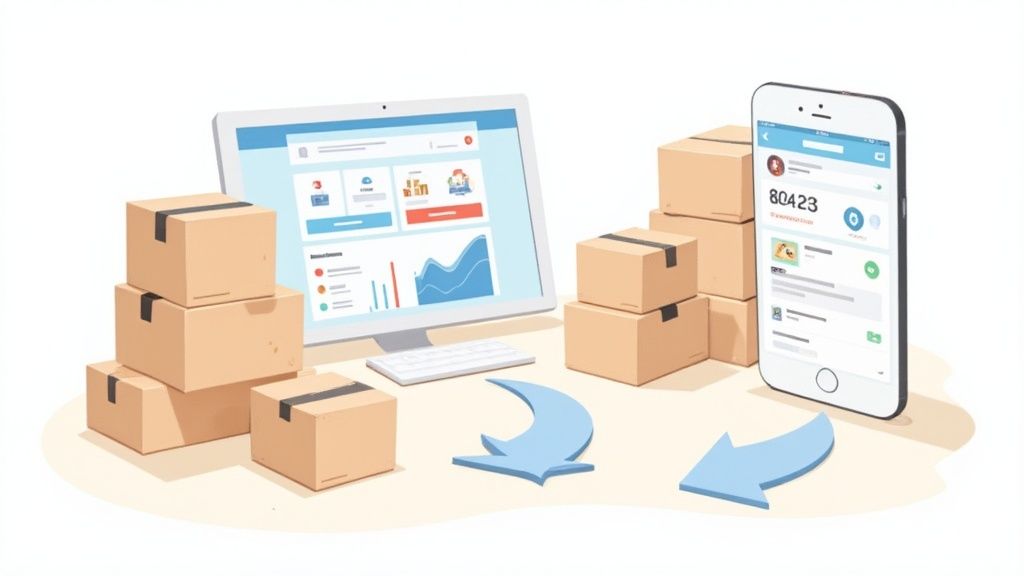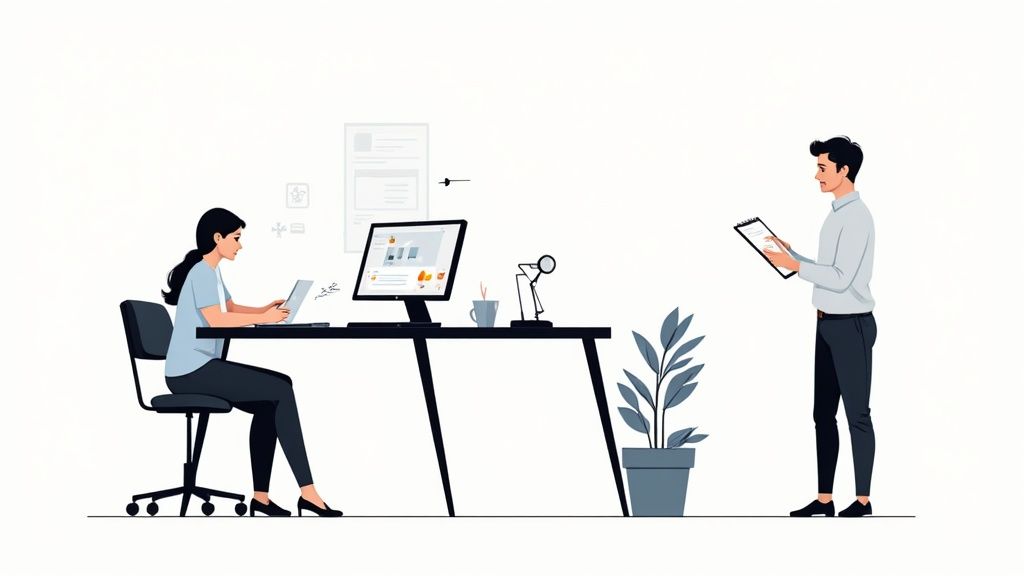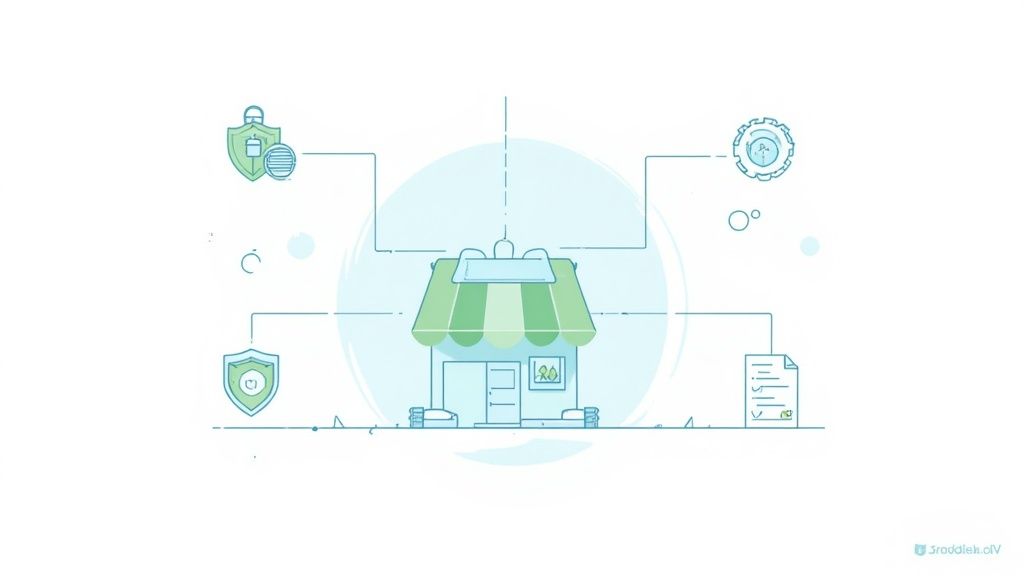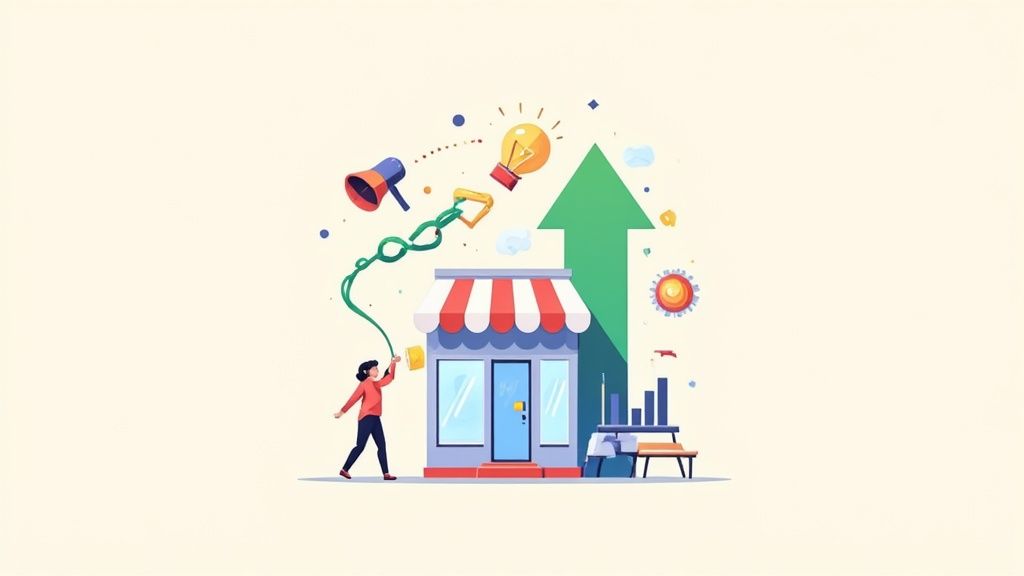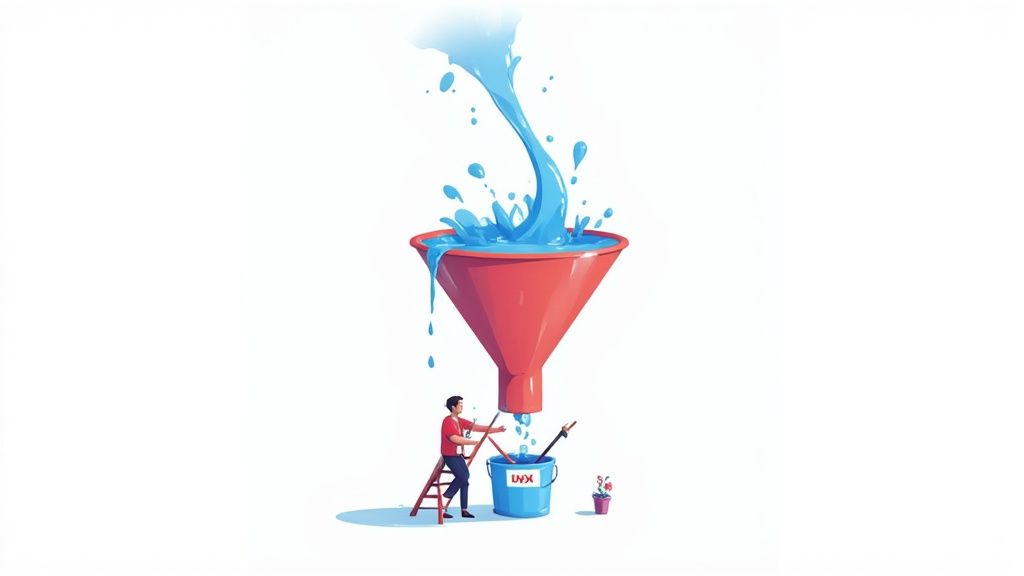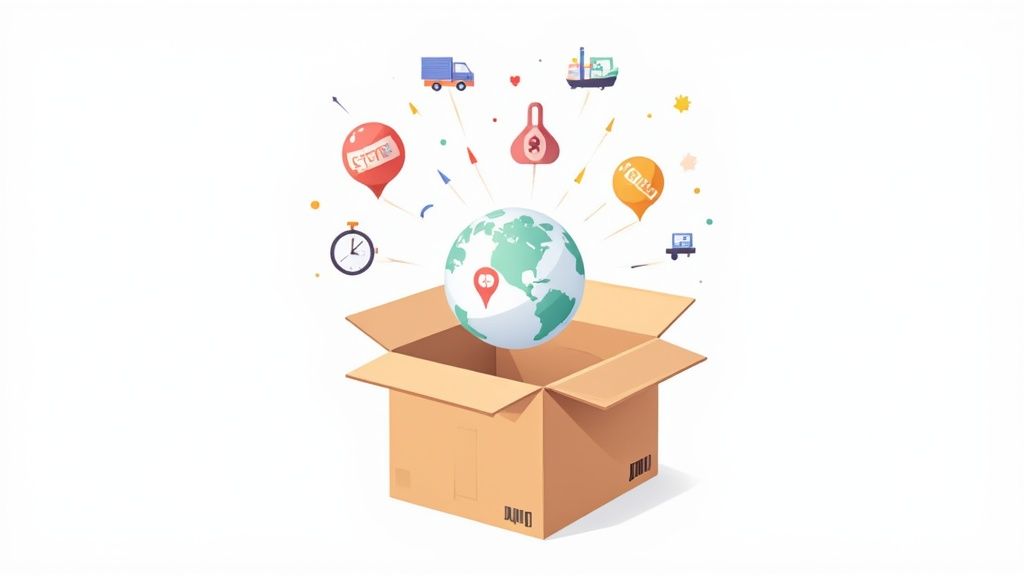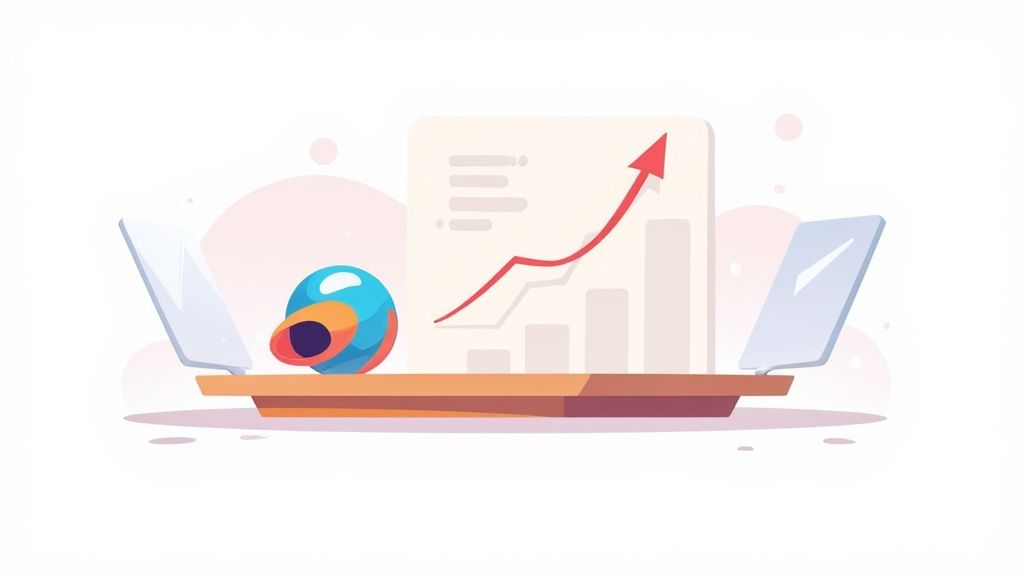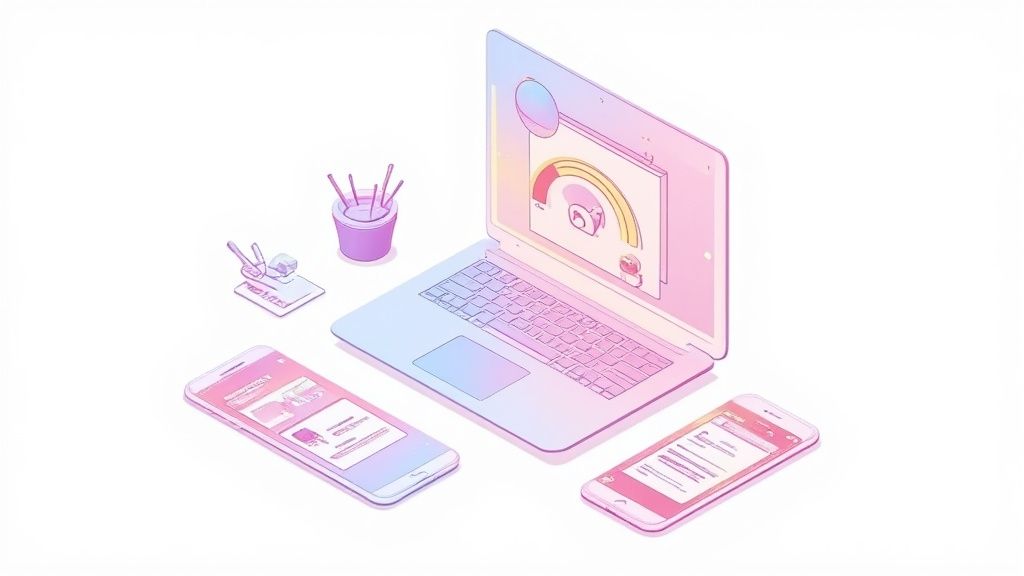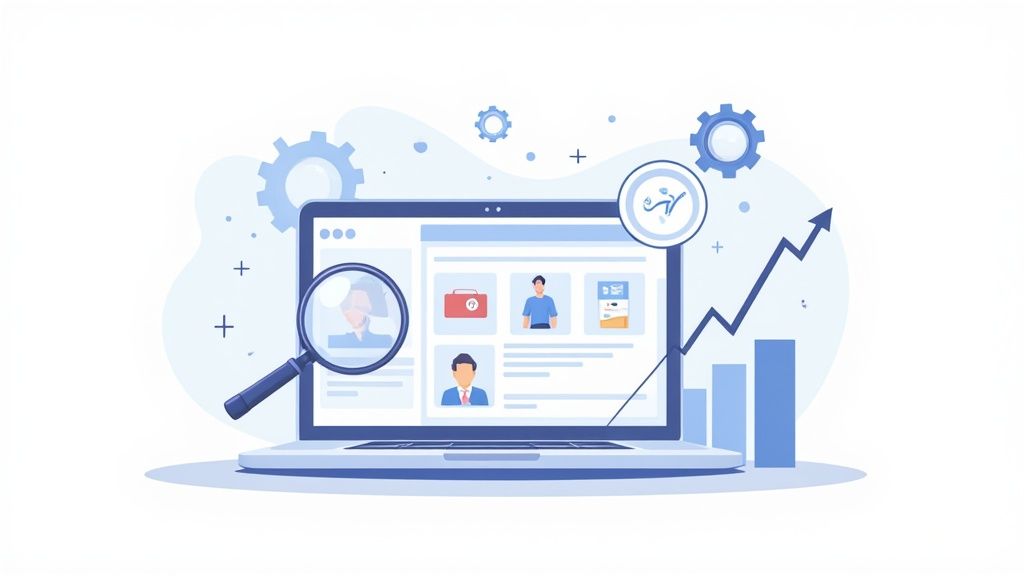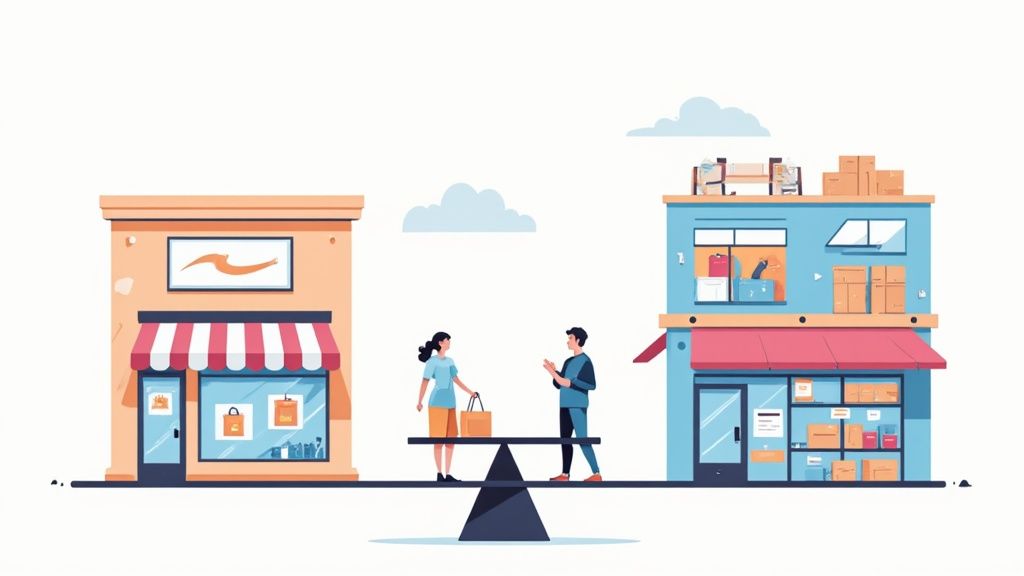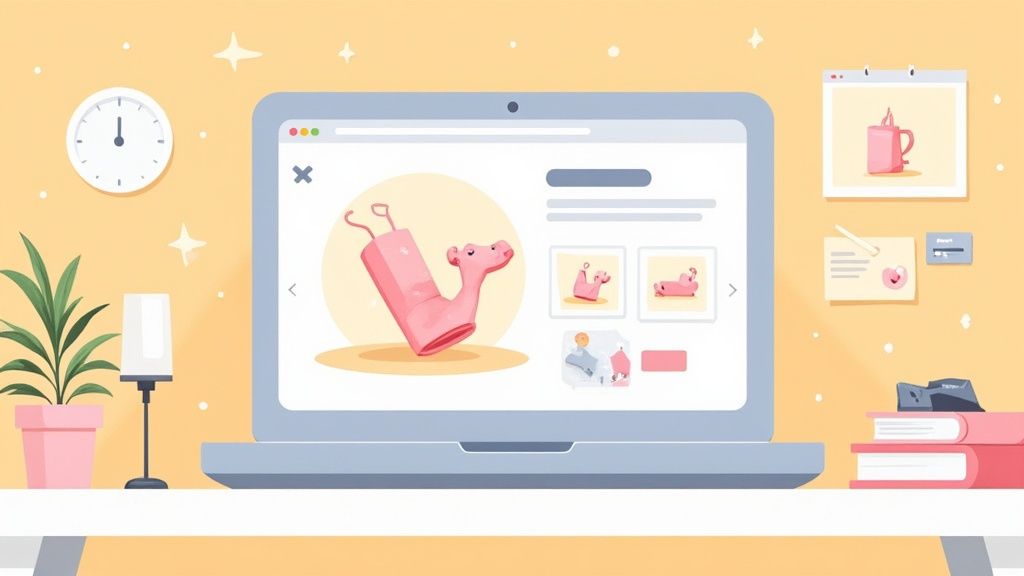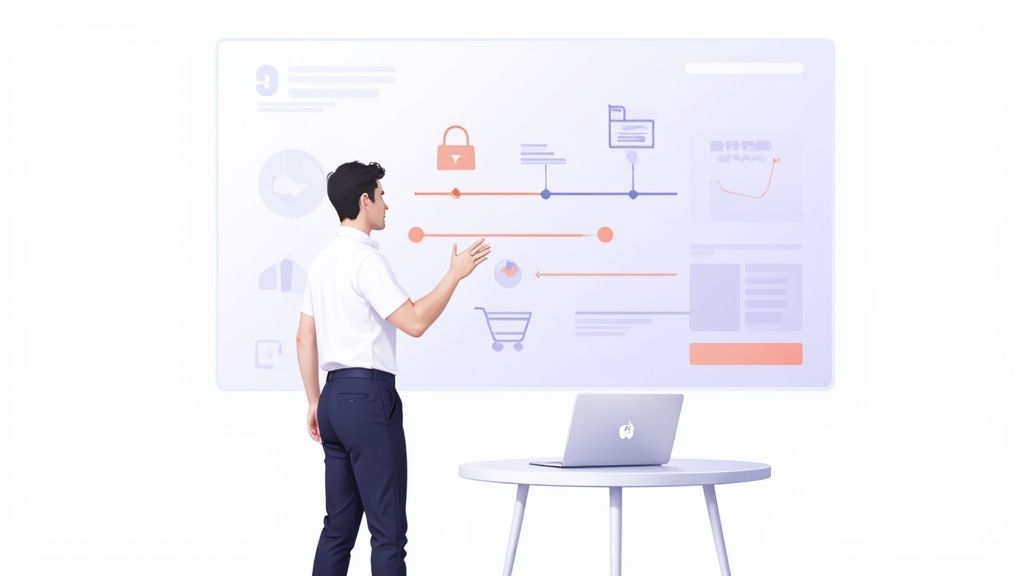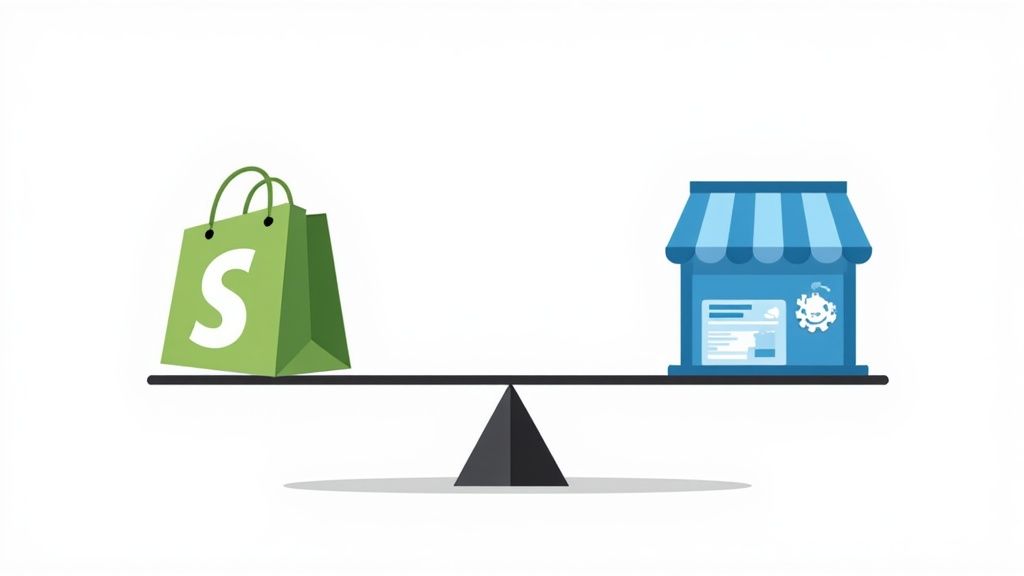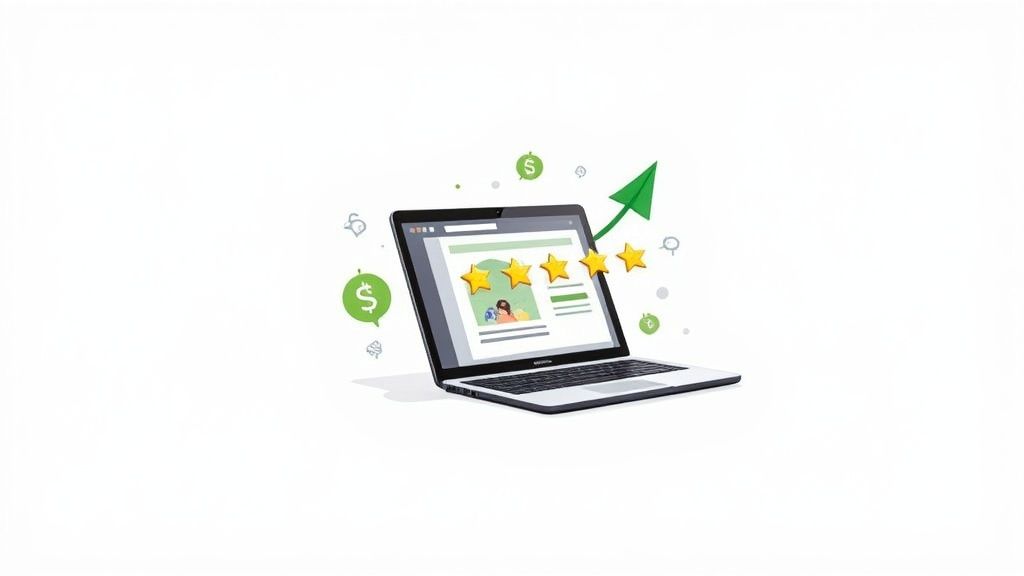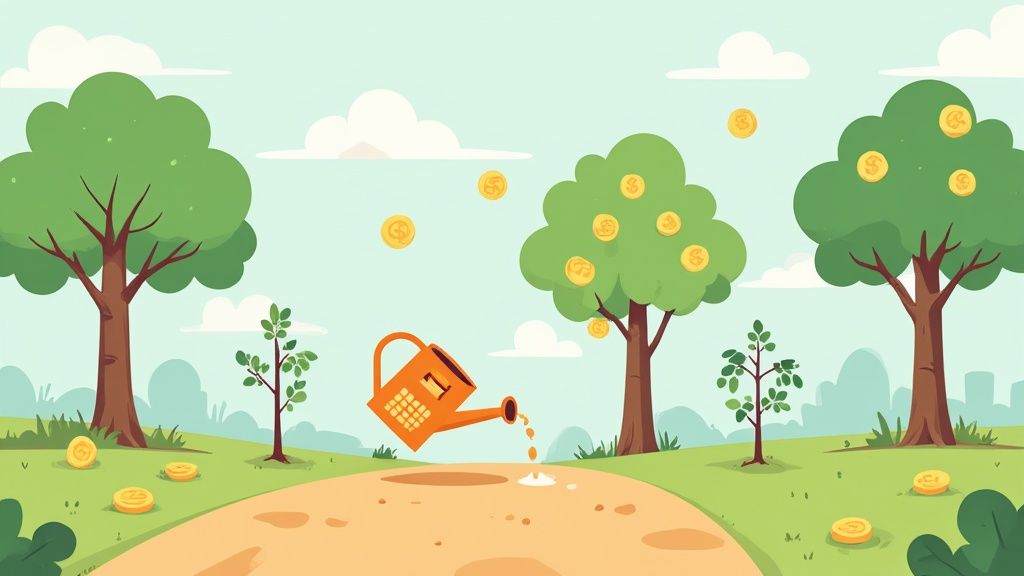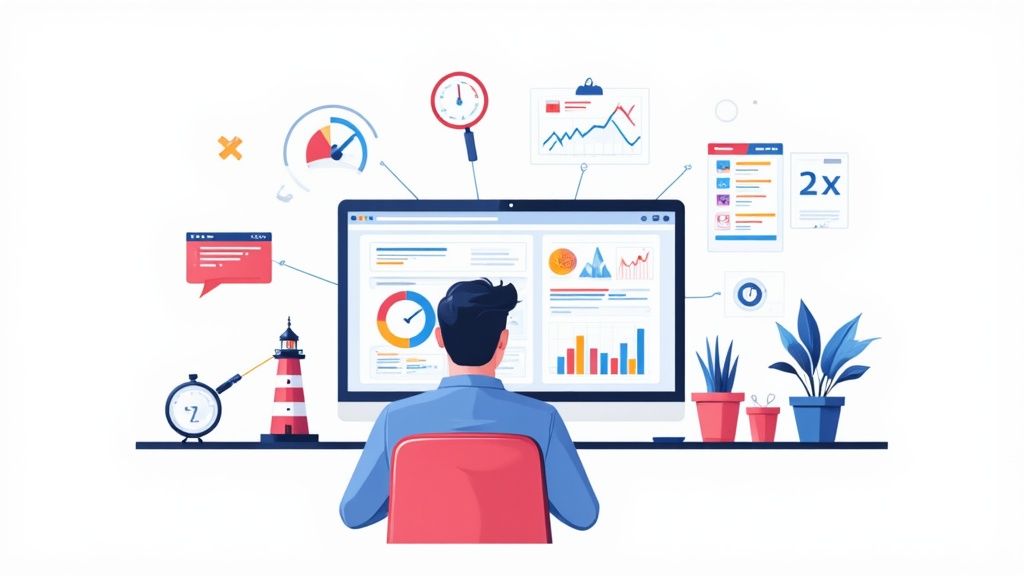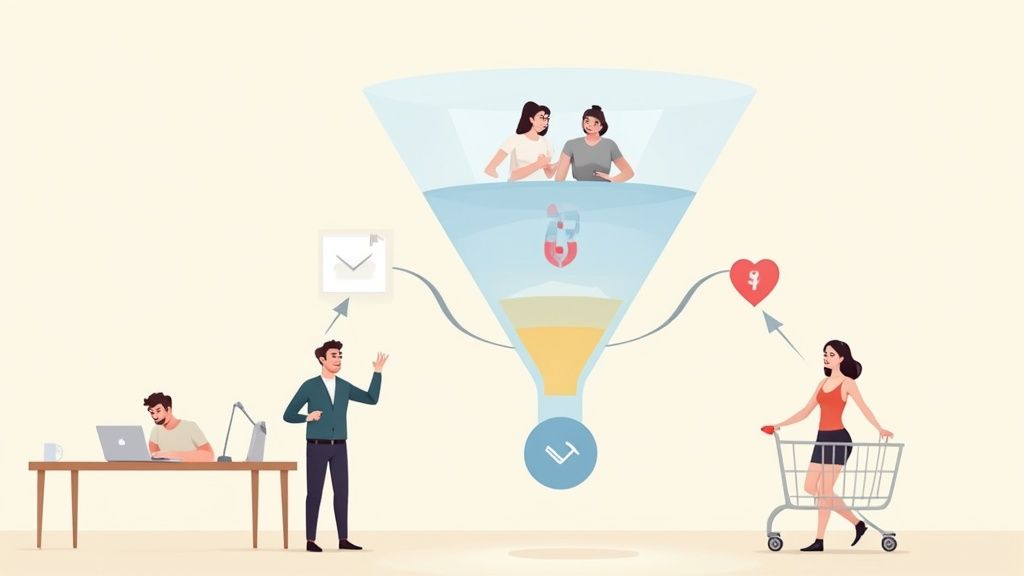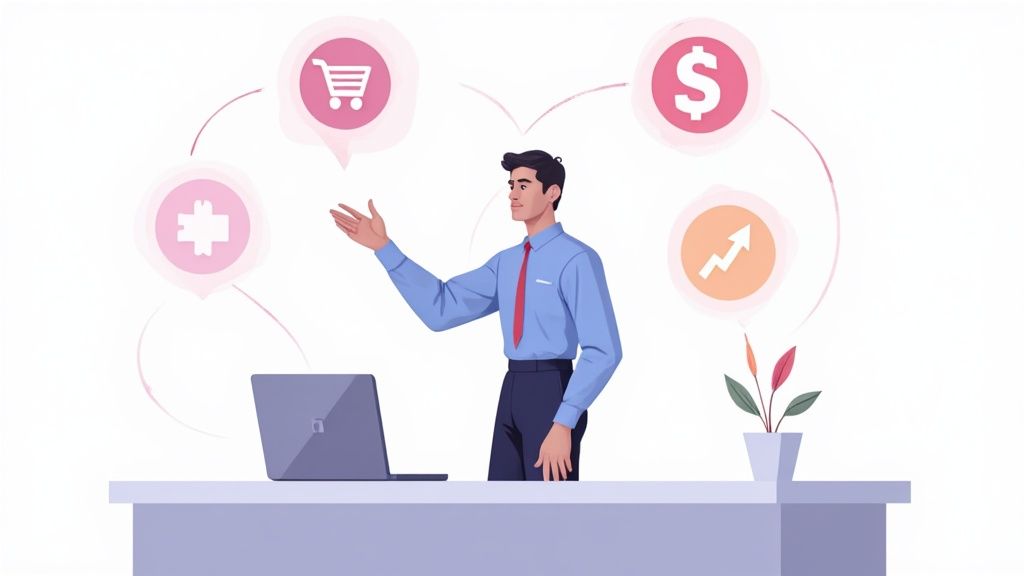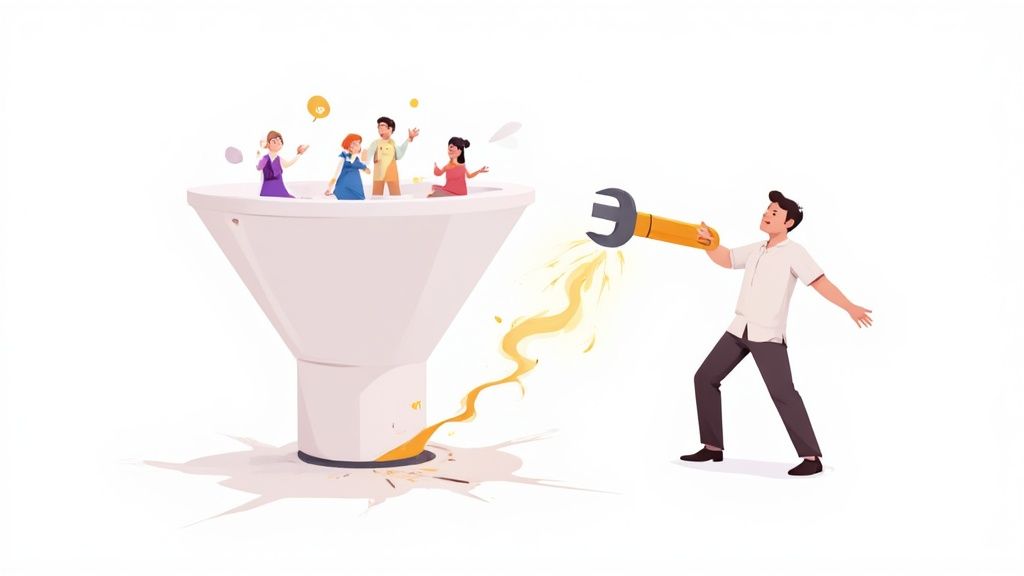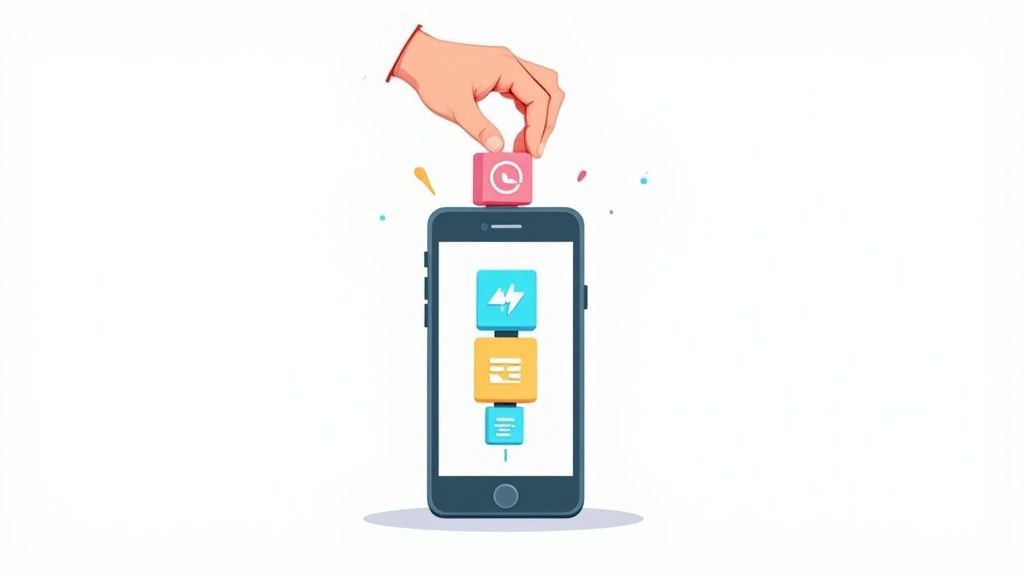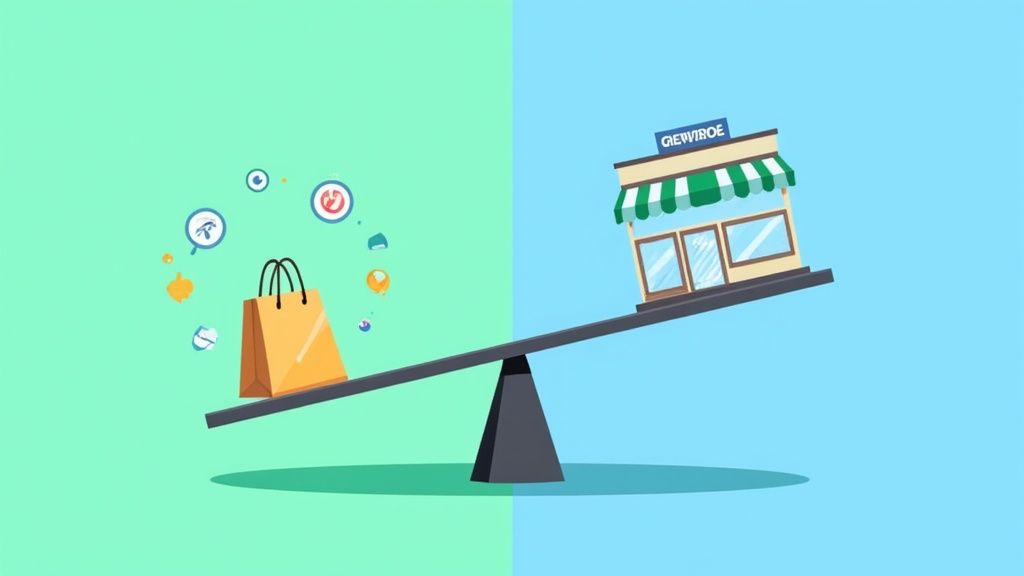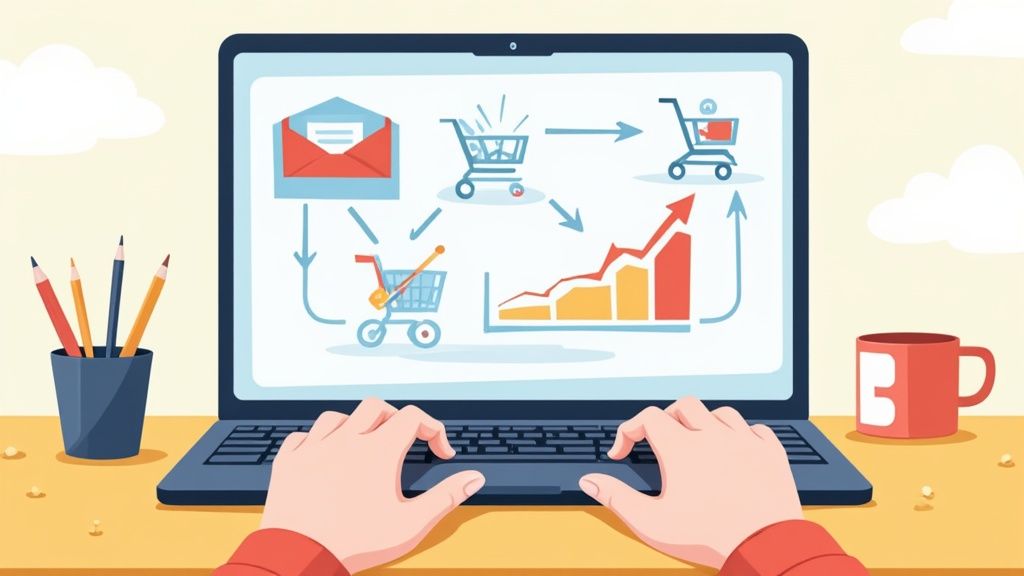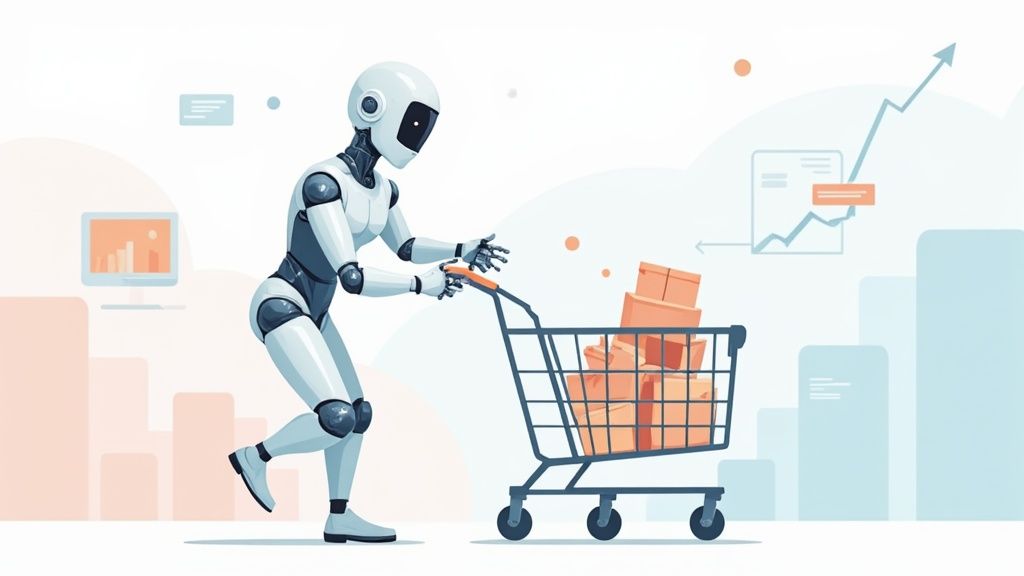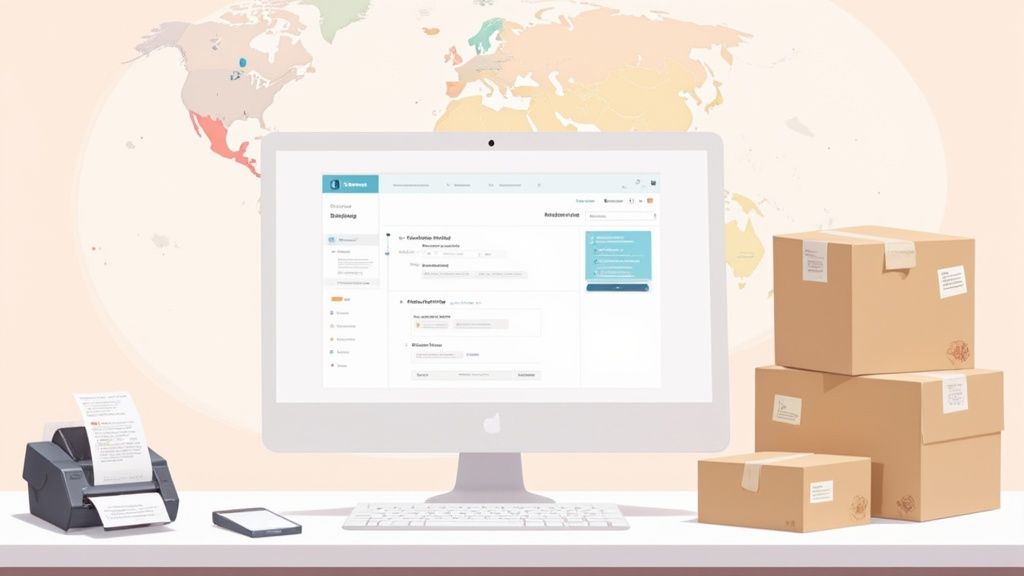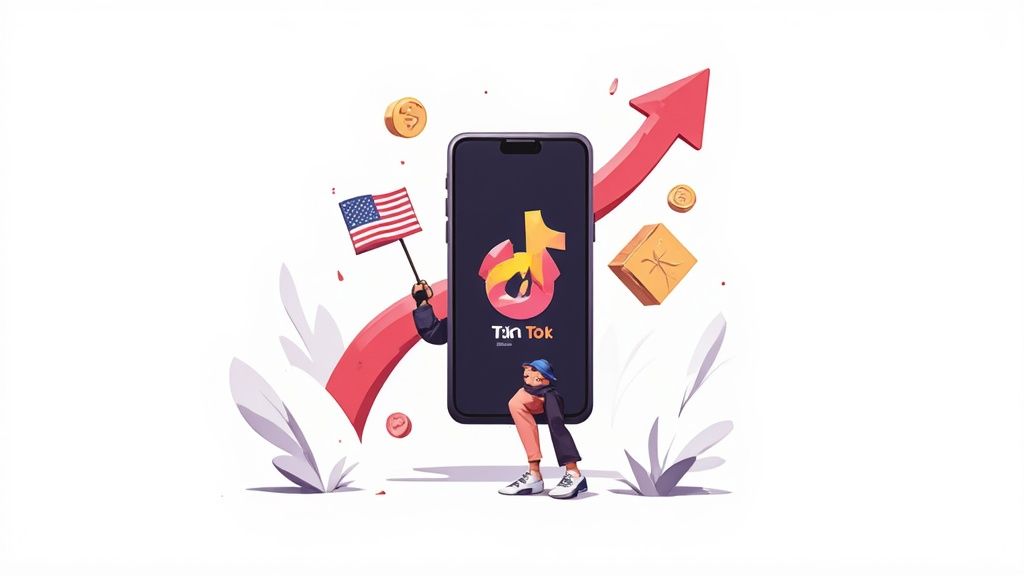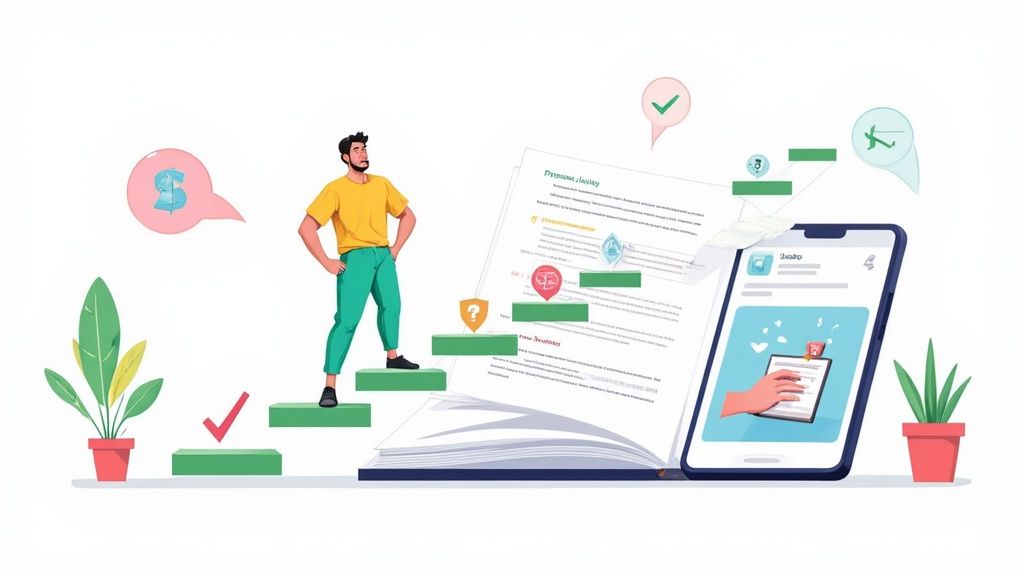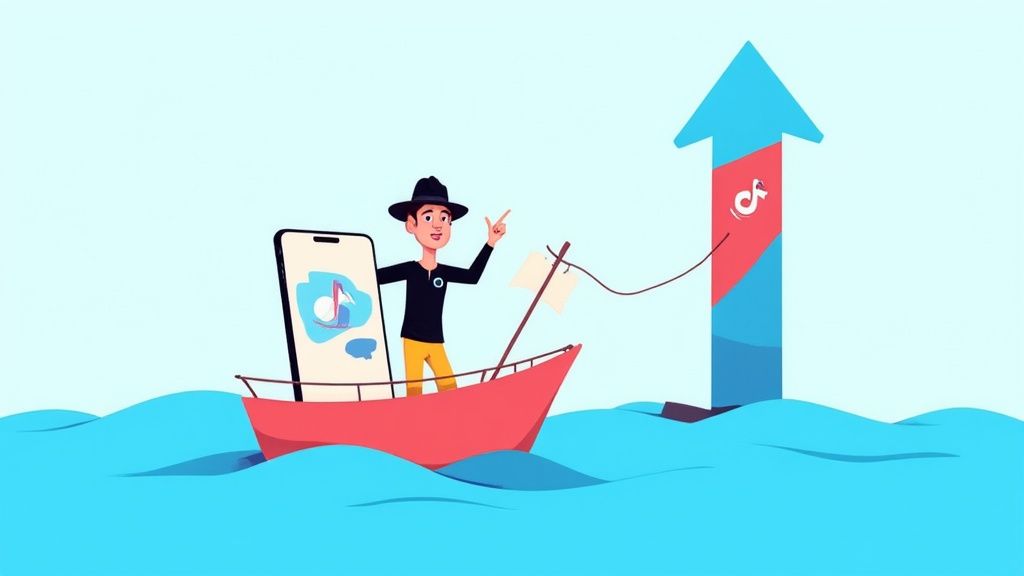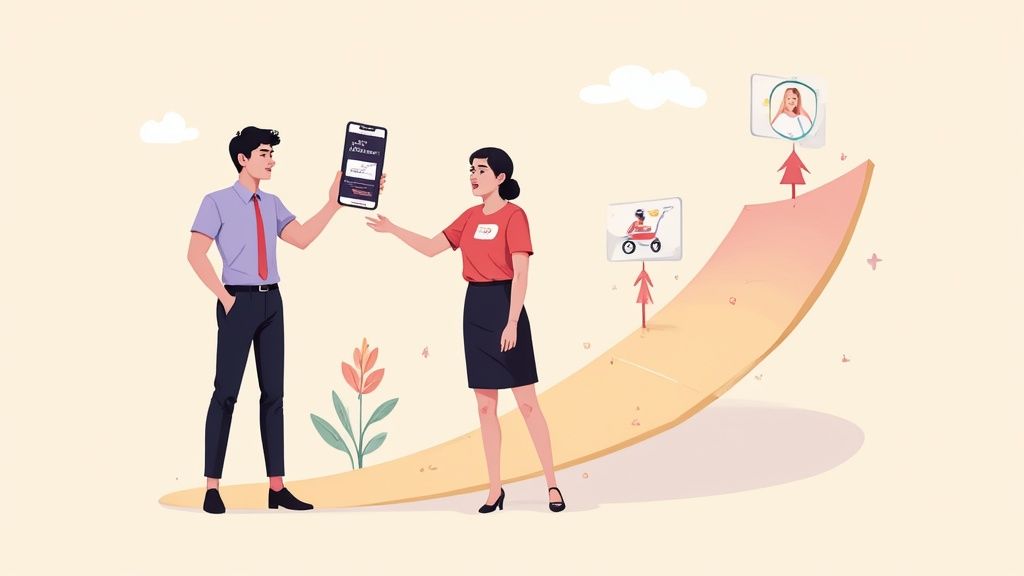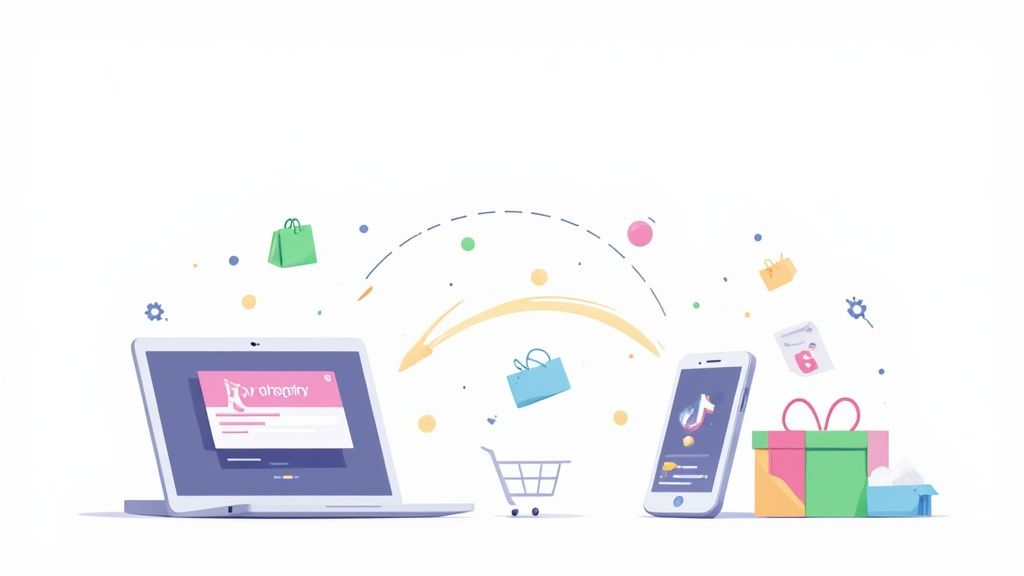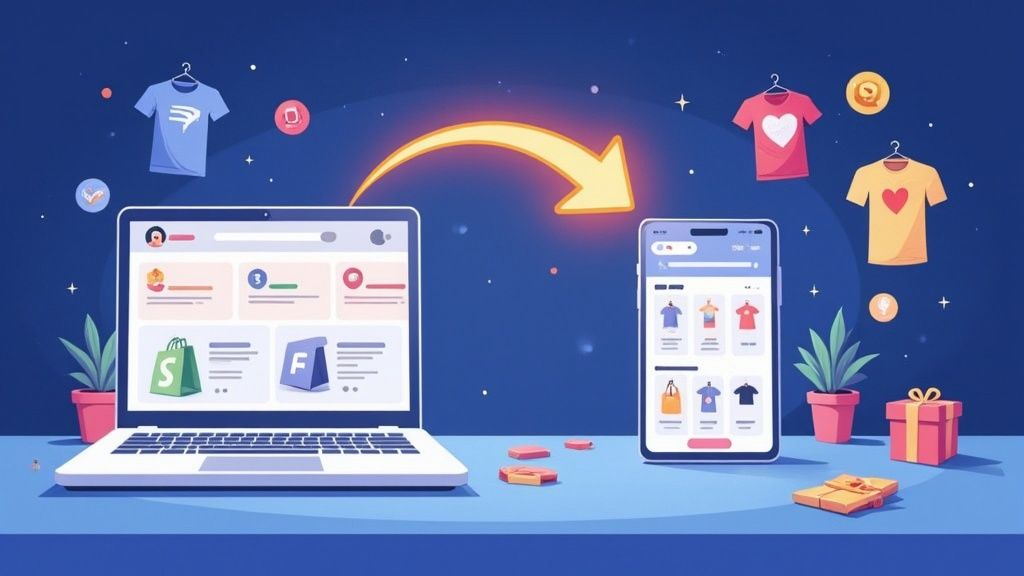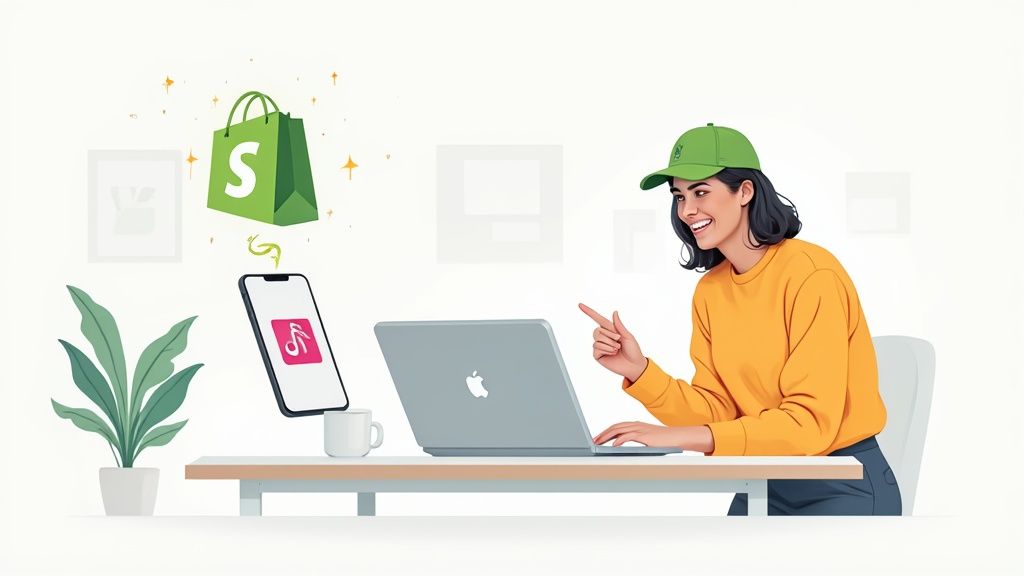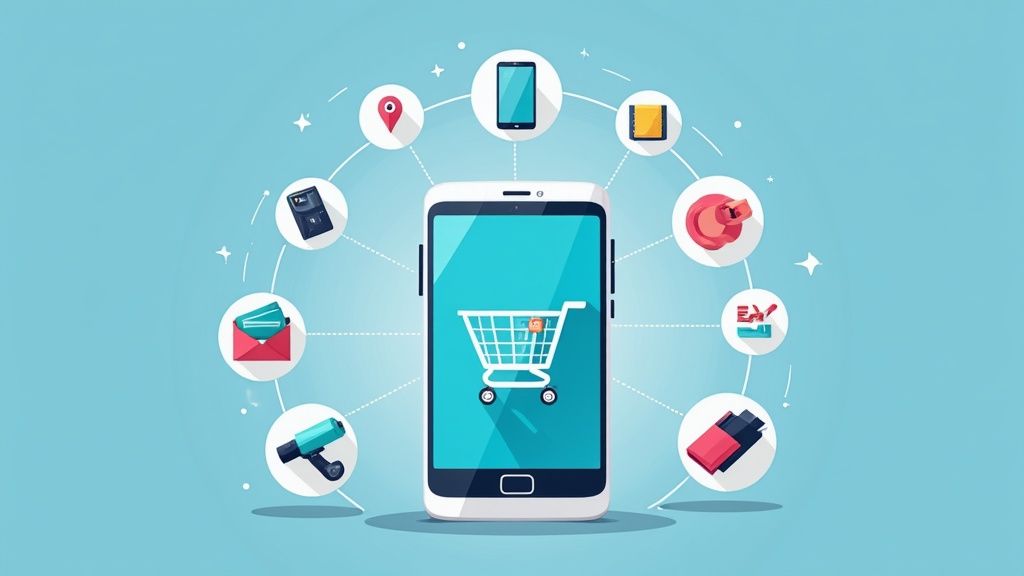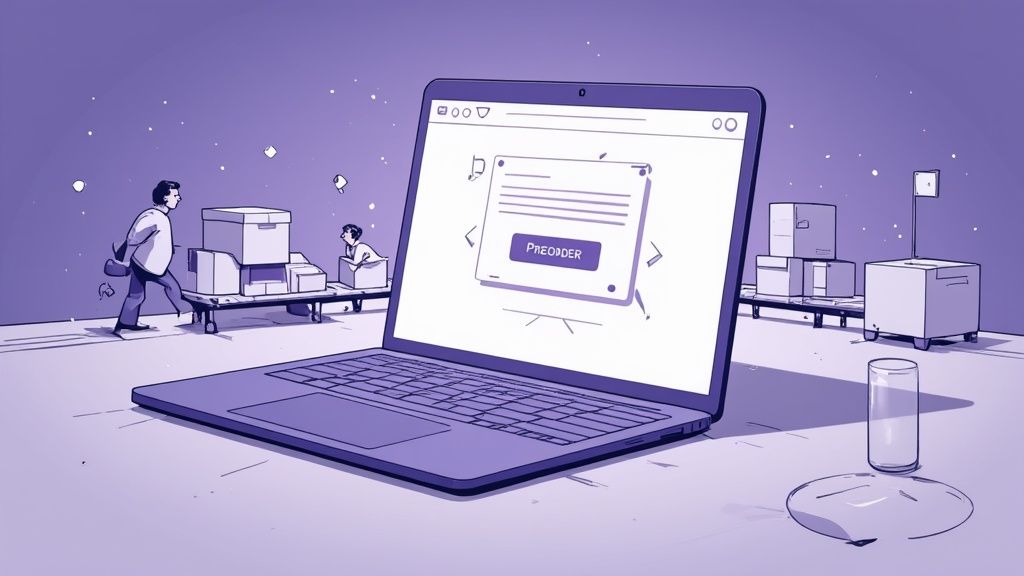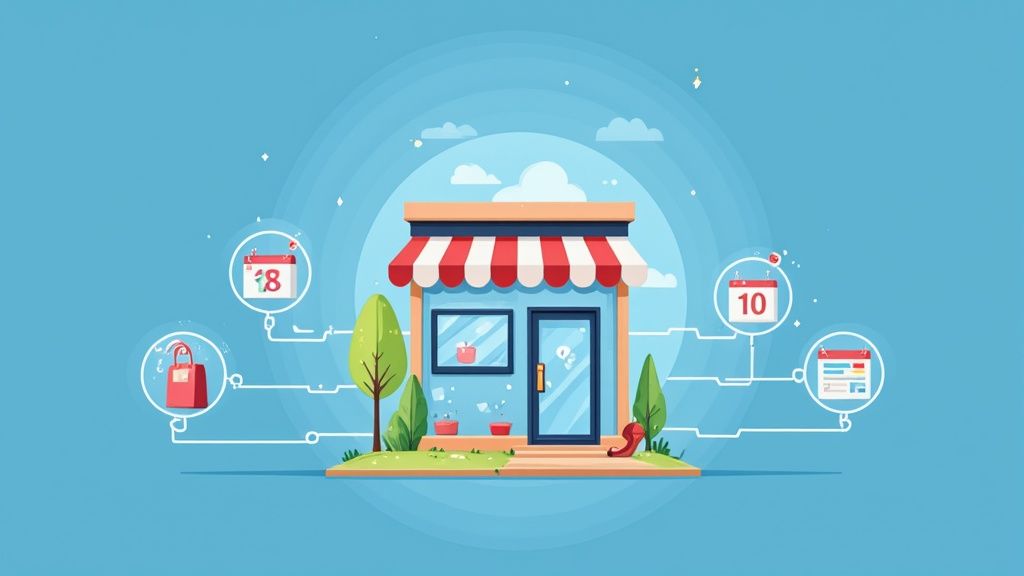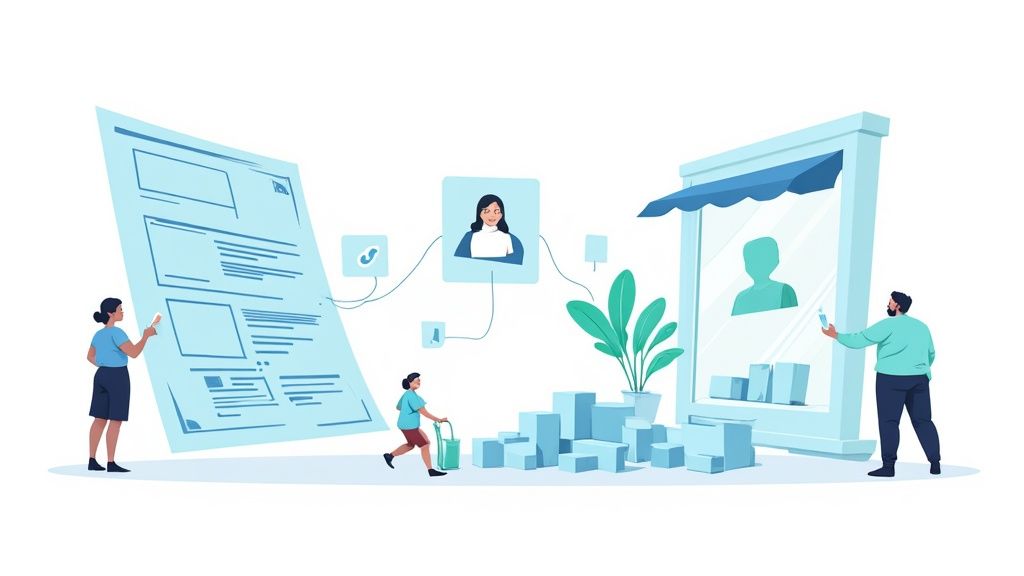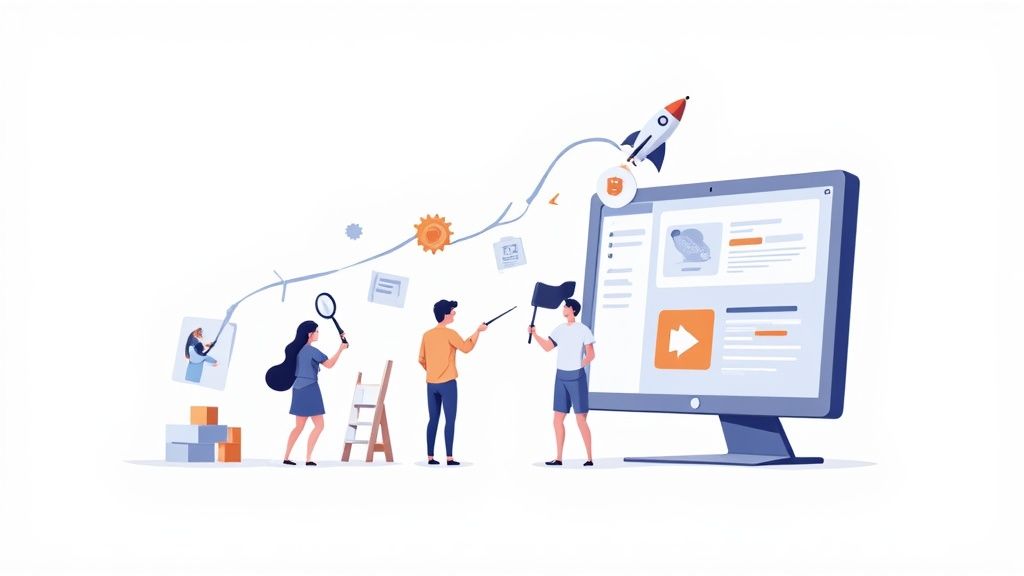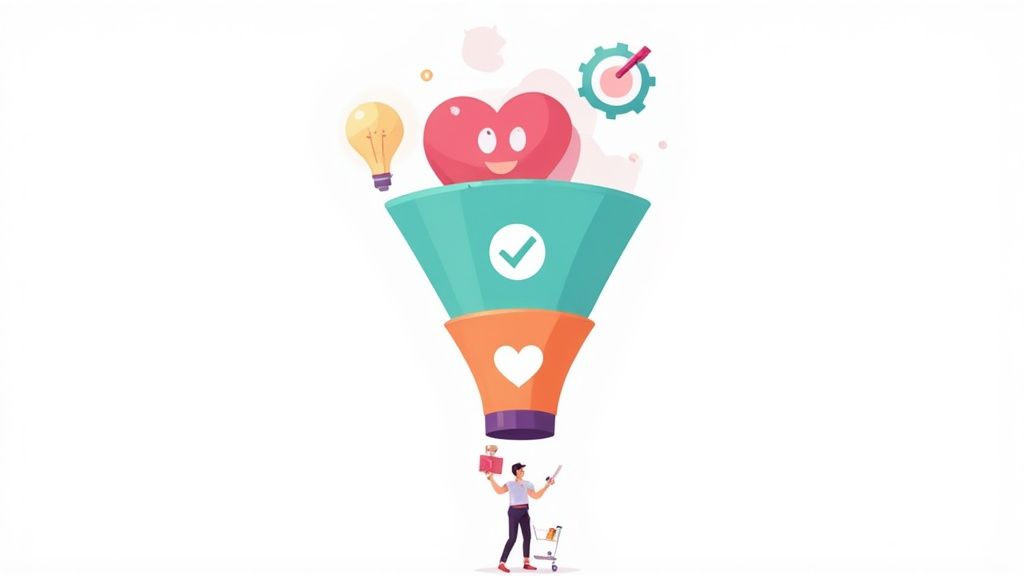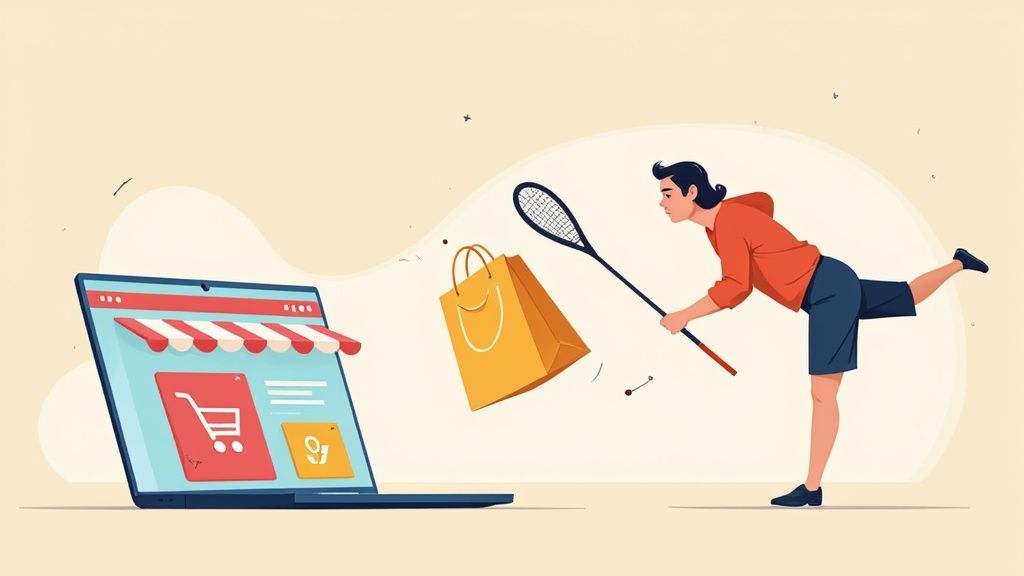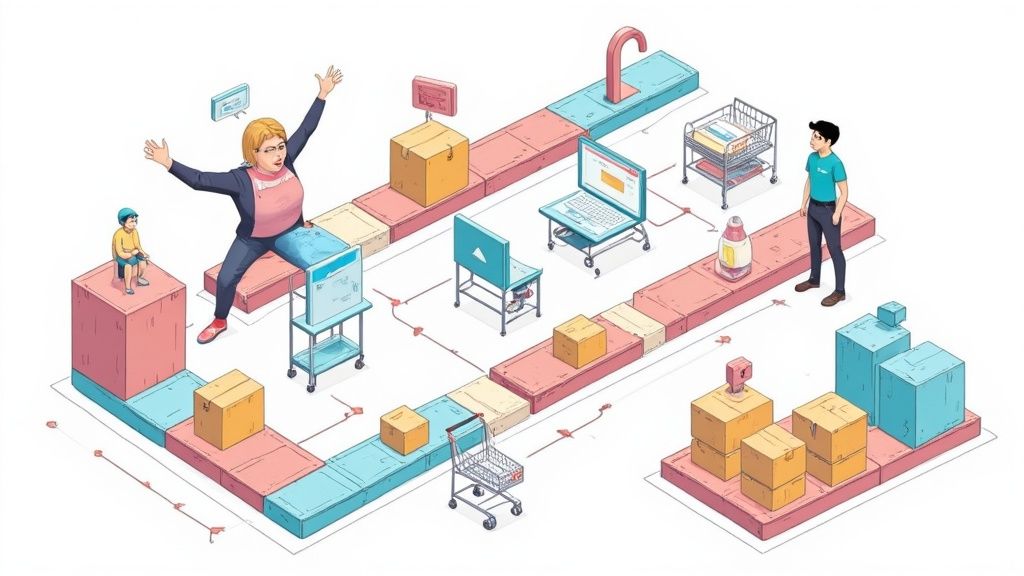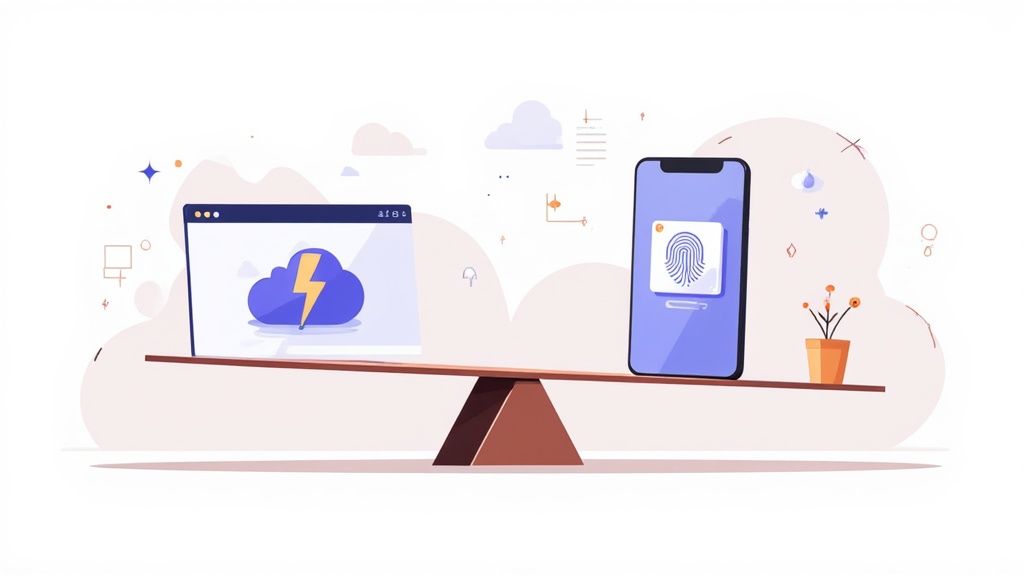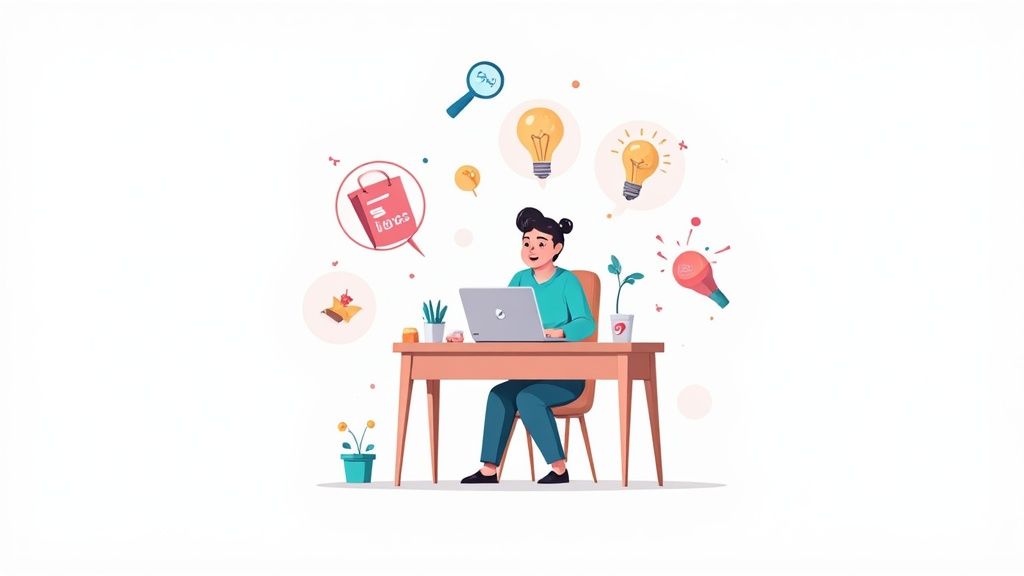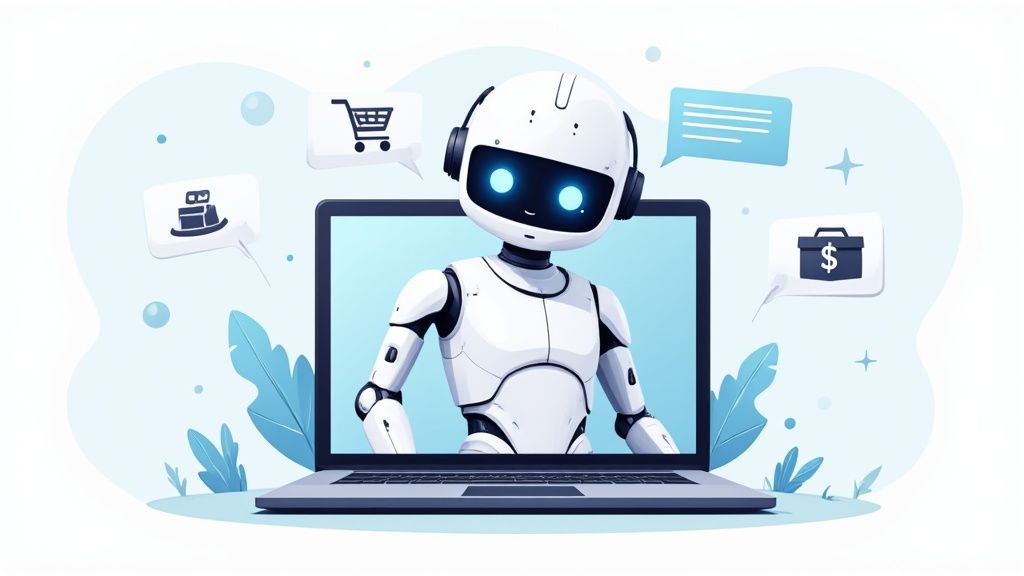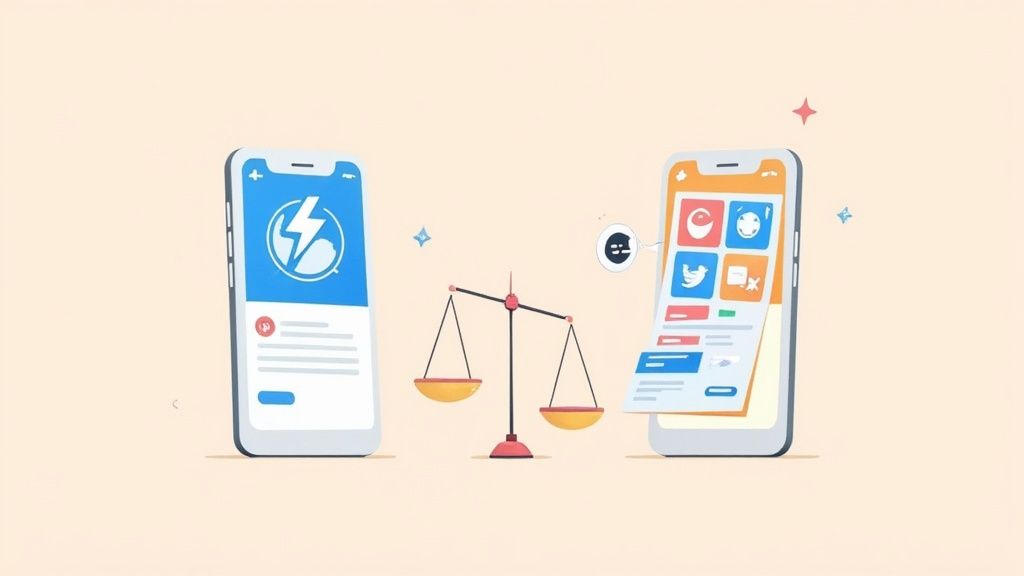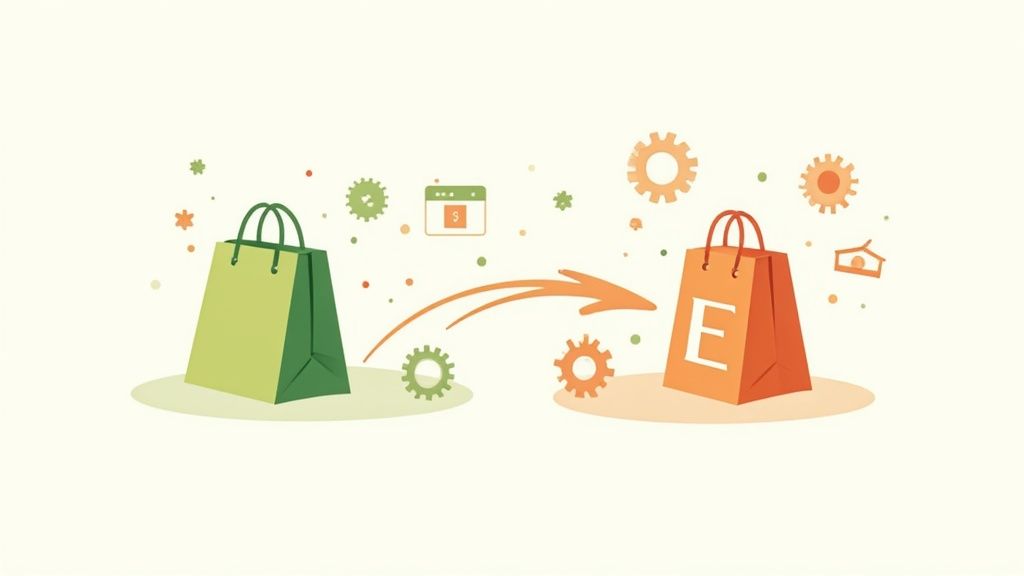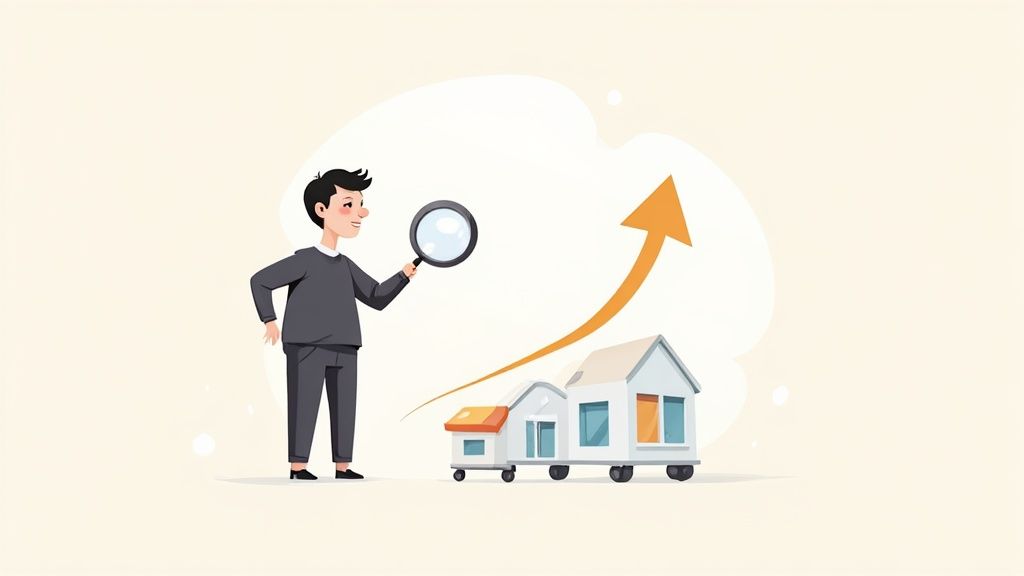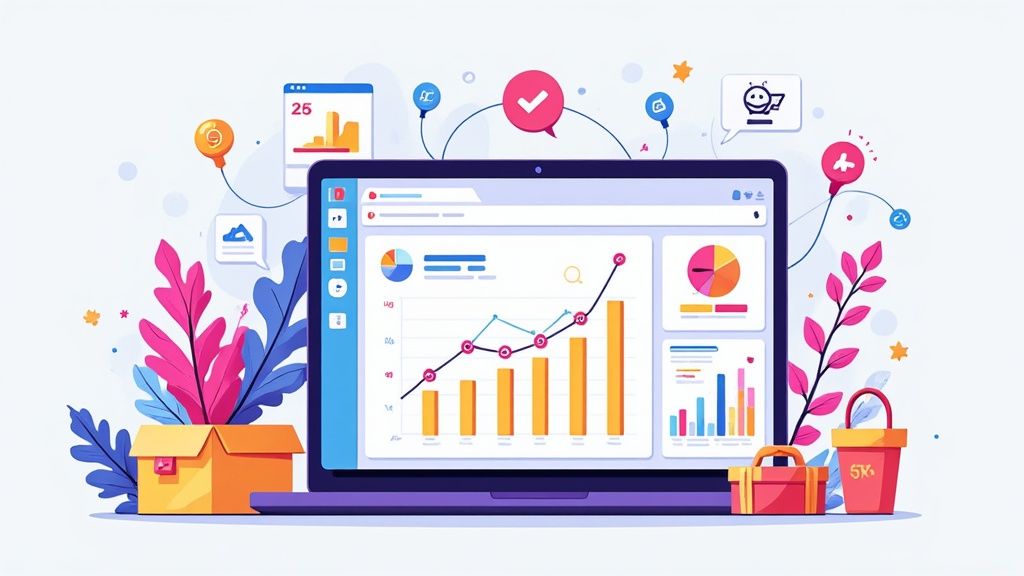
To seriously improve your ecommerce sales, you need a solid grasp of the forces shaping today's market. It’s no longer enough to just have your products listed online. Success now hinges on meeting modern customer expectations for mobile shopping, flawless payments, and experiences that feel personal. This guide is your roadmap to navigate these shifts and build a store that's geared for high growth.
Understanding the Modern Ecommerce Landscape
The ecommerce world is growing at a mind-boggling pace, but simply having an online presence doesn't cut it anymore. The strategies that worked even a year or two ago are becoming obsolete as customer habits change right under our feet. To really move the needle on revenue, you first have to understand the major trends defining the digital marketplace and position your store to take advantage of them.
This isn't about jumping on every new fad. It's about building a solid foundation based on where the market is actually going.
The scale of this growth is just staggering. Global ecommerce sales are on track to hit around $8.3 trillion in 2025, which is a massive 55.3% jump from 2021. And a huge chunk of that is happening on phones—over 70% of all online purchases will soon happen on a smartphone.
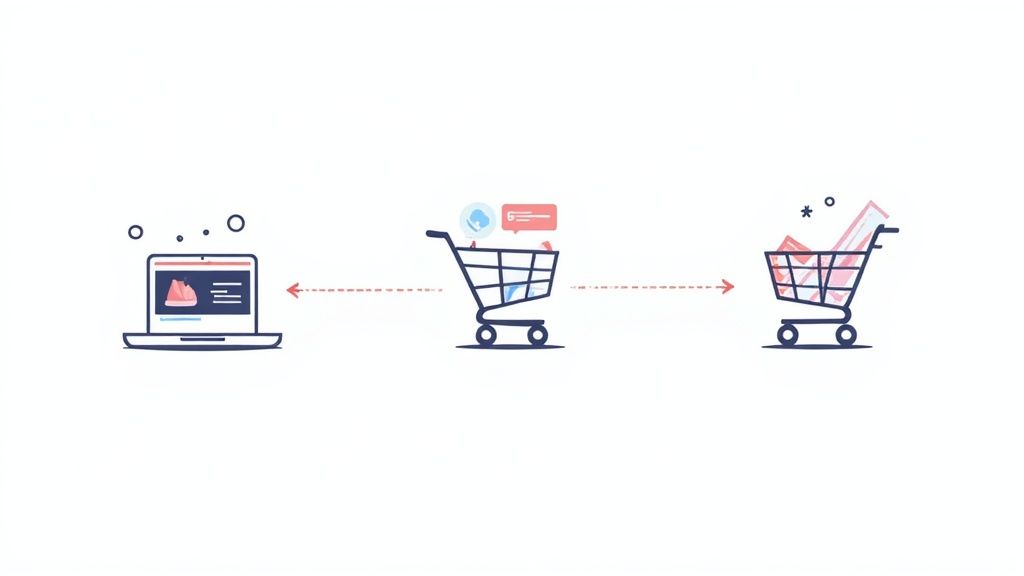
To help you get your arms around these changes, here’s a quick look at the big-picture drivers and what they mean for your store.
| Key Drivers of Modern Ecommerce Growth || :--- | :--- | :--- || Growth Driver | Key Statistic | Strategic Action for Your Store || Mobile-First Commerce | 70%+ of online sales will be mobile. | Prioritize a mobile-responsive design and a thumb-friendly checkout process. || Personalization | 80% of consumers are more likely to buy from a brand that provides personalized experiences. | Integrate AI-powered product recommendations and targeted marketing campaigns. || Seamless Payments | High cart abandonment rates are often tied to poor checkout experiences. | Offer multiple payment options, including digital wallets like Apple Pay and Google Pay. || Data Analytics | Data-driven companies are 23 times more likely to acquire customers. | Use analytics to track key metrics, understand customer behavior, and optimize your strategy. |
These drivers aren't just abstract concepts; they are the new rules of the game. Your ability to adapt to them will directly impact your bottom line.
Key Pillars For Boosting Shopify Revenue
Knowing these big-picture trends is step one. Step two is turning that knowledge into concrete actions for your Shopify store. We'll focus on four core areas that are absolute game-changers for sustainable growth in this environment.
- Optimizing for Conversions: We’ll break down how to turn more of your visitors into paying customers by fine-tuning your product pages, simplifying your checkout, and creating an experience people actually enjoy.
- Integrating AI Smartly: Artificial intelligence isn't just for the big guys anymore. We'll show you practical ways to use AI for things like personalized product recommendations and more efficient customer support.
- Building Recurring Revenue: It’s time to think beyond the one-time sale. You’ll learn how to launch subscription models that create predictable income and build incredible customer loyalty.
- Making Data-Driven Decisions: Stop guessing and start knowing. We'll dive into the essential analytics and KPIs you need to monitor to make sharp, profitable business decisions.
A huge piece of this puzzle is optimizing payment methods to eliminate any friction in the buying process. The rise of digital wallets and one-click checkouts has completely reset customer expectations.
The modern shopper craves convenience above all. A slow, clunky, or limited checkout is one of the quickest ways to lose a sale. Your store's ability to provide a smooth, trustworthy payment experience is directly linked to your ability to grow.
Get these four pillars right, and you’ll have a durable framework for not just surviving, but thriving. In the sections ahead, we’ll give you practical, step-by-step advice to put these strategies to work.
Turning Window Shoppers into Paying Customers with CRO
Getting traffic to your Shopify store is a great start, but it's only half the job. The real magic—and where you’ll see your revenue climb—is in converting those visitors into actual customers. This is the heart of Conversion Rate Optimization (CRO), and it's less about guesswork and more about a methodical process of making your site more persuasive.
It’s all about getting inside your customers' heads, understanding what makes them tick, and smoothing out any bumps in the road that might stop them from buying. You'd be surprised how a few small, smart changes can make a massive difference to your bottom line.
This simple flow shows how the key pieces of your website work together to guide a visitor from landing on your page to making a purchase.
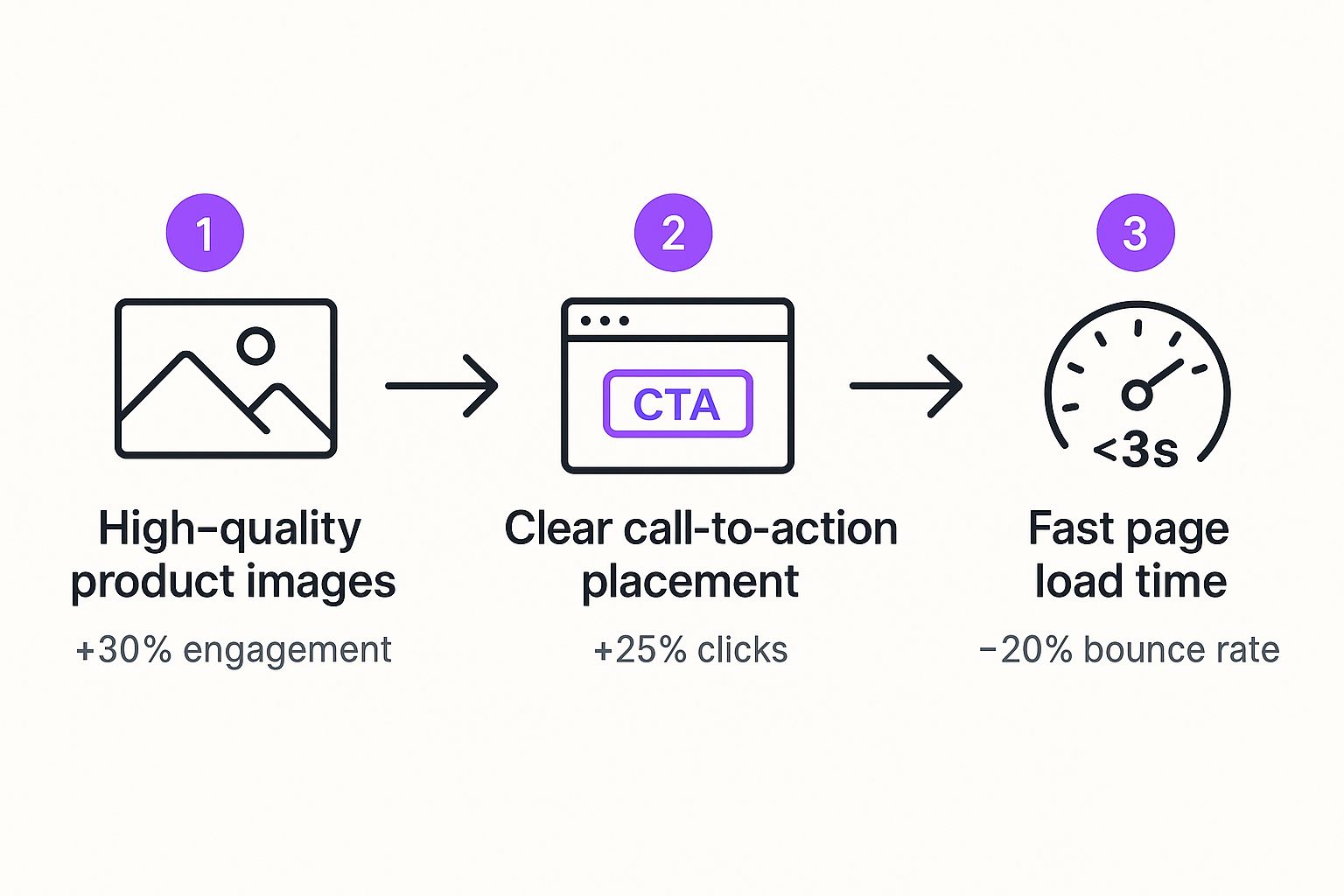
The takeaway here is crystal clear: a site that looks good, loads fast, and is easy to navigate is fundamental to keeping people around long enough to click "Add to Cart."
Designing High-Impact Product Pages
Your product page is the final sales pitch. This is where a customer decides "yes" or "no." It needs to do the heavy lifting—building trust, answering questions, and creating desire. Forget about generic descriptions and stock photos; they just don't cut it anymore.
A truly effective product page knows what a customer is thinking and gives them the answer before they even have to ask. The goal is to shift from just listing features to explaining benefits—how does this product actually make their life better?
For instance, don't just say a backpack has "durable nylon construction." Instead, try "built with water-resistant nylon to keep your laptop safe and dry on those rainy morning commutes." See the difference? You’re painting a picture and solving a real-world problem.
A product page must do more than just show off a product; it has to build confidence. Research shows that 89% of customers will buy again after a great first experience, and that experience often begins right here.
Here are a few things you can do right now to level up your product pages:
- Write Compelling Descriptions: Ditch the spec sheet mentality and tell a story. Who is this for? What problem does it solve? Use bullet points to make the core benefits easy to scan for busy shoppers.
- Use High-Quality Visuals: Show your product from every angle with crisp, high-resolution images. Add lifestyle photos of the product in action, and if you can, a short video is often the best way to demonstrate its value.
- Feature Social Proof Strategically: Over 90% of people read reviews before buying something online. Put your best reviews and star ratings where they can't be missed. Even better, showcase user-generated content like photos from your customers—it's authentic and incredibly powerful.
Deconstructing the Checkout for Fewer Abandoned Carts
The checkout is the last hurdle, and it's a place where countless sales are lost to frustration and friction. A shockingly high number of carts are abandoned, and a clunky, confusing checkout flow is usually the culprit. Your one and only goal here is to make paying as quick and painless as possible.
Every extra field a customer has to fill out, every unnecessary click, and every moment of confusion is another reason for them to give up and leave. Streamlining the journey from cart to confirmation is one of the highest-impact changes you can make to boost sales, sometimes almost instantly.
Think of it like the express lane at the supermarket. People with their wallets out just want to get through without any hassle.
Key Strategies for a Frictionless Checkout
Put yourself in your customer’s shoes and walk through your own checkout process. Does every step make sense? Is the total cost clear from the start? Here are some proven ways to cut down on friction and get more people across the finish line.
Simplify Your Forms
Only ask for what you absolutely need to fulfill the order. Does the billing address need to be separate if it's the same as the shipping? Is a phone number truly essential? Every field you eliminate makes the process feel faster and easier.
Offer Guest Checkout
Forcing someone to create an account before they can give you their money is a massive conversion killer. Always, always have a highly visible guest checkout option. You can always ask them to create an account after the purchase is complete, when the hard part is over.
Integrate Multiple Payment Options
People have their favorites. Beyond just credit cards, offering digital wallets like Apple Pay, Google Pay, and Shop Pay is no longer a "nice-to-have"—it's expected. These one-click options are a game-changer, especially for the huge number of people shopping on their phones.
- Trust Seals: Displaying recognizable payment logos and security badges (like Norton or McAfee) is a simple visual cue that tells customers their information is safe.
- Clear Progress Indicators: Show people where they are in the process (e.g., Shipping > Payment > Confirm). It reduces anxiety and lets them know they're almost done.
- Transparent Costs: Surprise shipping fees are the #1 reason for cart abandonment. Be upfront about all costs, including taxes and shipping, before the customer even starts the checkout.
By putting these CRO tactics into practice, you start to transform your store from a simple online catalog into a finely-tuned machine designed to turn browsers into loyal customers.
Using AI to Create Personalized Shopping Journeys
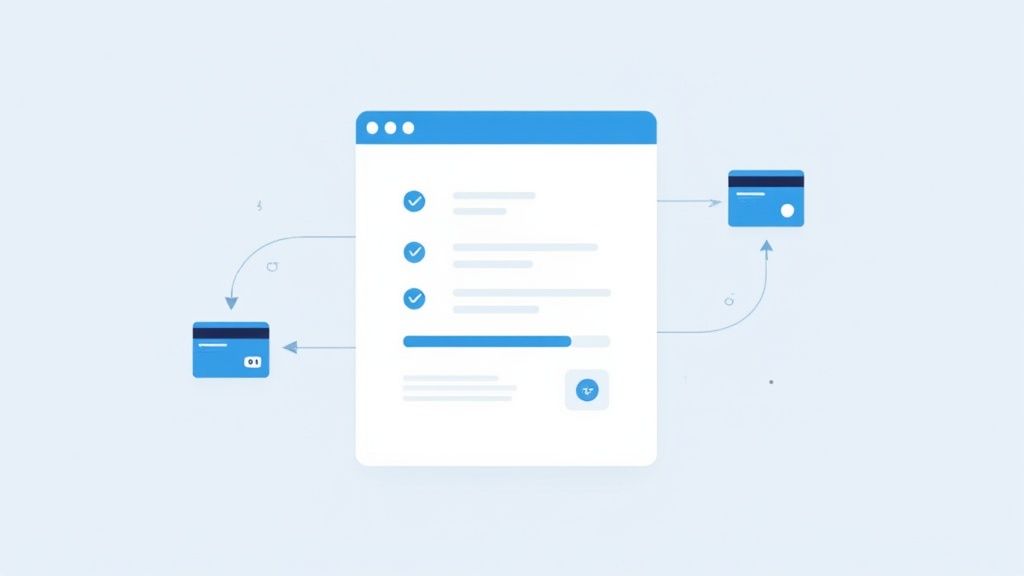
Artificial intelligence isn't some far-off concept for Silicon Valley giants anymore. It's a real, practical tool that can fundamentally change your customer experience and, as a result, seriously improve your ecommerce sales. The true magic of AI is its ability to learn from customer behavior and deliver a one-to-one experience on a scale that’s just not possible for a human team to pull off.
Instead of hitting every visitor with the same generic homepage, AI lets you build unique, personalized shopping journeys that feel genuinely helpful. This is the big shift—moving away from a one-size-fits-all model to one that makes every single customer feel seen and understood. Honestly, it’s what separates the stores that are thriving from the ones getting left behind.
AI-Powered Product Recommendations
One of the quickest wins with AI is to overhaul your product recommendations. Those basic "Customers also bought" widgets are fine, but real AI digs so much deeper. It looks at what a shopper is doing right now—their browsing behavior, past purchases, even what they just added to their cart—to serve up hyper-relevant suggestions.
This is a world away from static, manually picked collections. An AI engine can instantly change its recommendations if a customer who was looking at hiking boots suddenly clicks over to rain jackets. The suggestions adapt on the fly, making them far more likely to actually convert.
For example, a Shopify app like Rebuy or LimeSpot can plug right into your store and start learning from your customer data almost immediately. They create dynamic carousels on product pages and at checkout, like "Complete Your Look" or "Frequently Bought Together," that are uniquely tailored to each shopper.
The impact here is huge. We've seen personalized product recommendations increase average order value (AOV) by as much as 30%. It’s one of the fastest ways to squeeze more revenue out of the traffic you already have.
Intelligent Chatbots for 24/7 Support
Modern shoppers want answers now. They aren't going to spend time digging through a dense FAQ page or wait a day for an email reply. This is where AI-powered chatbots come in, acting as a 24/7 sales assistant that can handle tons of questions without ever getting tired or overwhelmed.
And I'm not talking about those clunky, frustrating bots from a few years ago. Today's intelligent chatbots can:
- Answer Complex Questions: Handle specific queries about your shipping policy, return process, or product details.
- Guide Shoppers to Products: Ask smart, clarifying questions to figure out what a customer needs and then point them to the perfect product.
- Recover Abandoned Carts: Proactively chat with shoppers who have items sitting in their cart, offering help or maybe a small incentive to get them across the finish line.
Bringing in a tool like Tidio or Gorgias can turn your customer support from a cost center into a powerful revenue driver. It frees up your human team to focus on the truly complex issues while the bot handles the routine stuff, making sure no sale is lost over a simple, unanswered question.
Deeply Personalized Email Marketing
Let's be real: generic email blasts barely get opened. AI lets you go way beyond just adding a first name to the subject line and start sending emails that feel like they were written for one person. By plugging into your store's data, AI can trigger emails based on very specific customer actions.
Picture this: a customer looks at a specific pair of sneakers twice but doesn't pull the trigger. An AI system can automatically send them an email the next day featuring that exact product, maybe with some top-rated reviews or a video of the shoes in action. You can dive deeper into these powerful strategies in our full guide on how to use AI in ecommerce. That’s the kind of personal touch that turns a casual browser into a loyal customer.
Building Predictable Revenue with Subscription Models
If you're looking for a powerful way to stabilize your business and unlock serious growth, it's time to look beyond one-off sales. Subscriptions are a game-changer. They turn unpredictable transactions into a steady, reliable stream of recurring revenue, giving you a rock-solid financial foundation to build on.
But it's not just about predictable income. It's about building deeper relationships with your most loyal customers.
Implementing a subscription program is one of the most direct ways to improve ecommerce sales by blowing up your Customer Lifetime Value (CLV). Instead of just hoping a customer comes back, you’re creating a system where repeat business is automatic. This fundamentally changes how you can forecast revenue, manage your inventory, and plan for the future.
Choosing the Right Subscription Model for Your Store
Not every subscription model fits every store. The real magic happens when you match the model to your products and, more importantly, to your customers' habits. The goal is simple: offer so much convenience or value that subscribing becomes an absolute no-brainer for them.
From my experience working with countless Shopify stores, three models consistently deliver the best results:
Replenishment (The "Subscribe and Save"): This is the classic and for good reason. It’s perfect for any consumable product people use up and re-buy. Think coffee, skincare, vitamins, protein powder, or pet food. The value proposition is crystal clear: ultimate convenience and a nice little discount. Your customers get what they need, right when they need it, without ever having to think about it.
Curation (The "Discovery Box"): This model is all about surprise, delight, and discovery. It works wonders for brands in niches like craft foods, beauty, apparel, or unique hobbies where customers love trying new things. Every month, you send a hand-picked selection of products. Here, the value isn't just the products themselves, but your expertise and the excitement of the unboxing experience.
Access (The "VIP Membership"): This model is built on exclusivity. Subscribers pay a recurring fee for special treatment. This could be members-only discounts, early access to new product drops, free shipping on everything, or entry into a private community. It's a fantastic fit for brands with a strong, passionate community or those selling high-end products where being an "insider" is a major draw.
A well-executed subscription program can boost customer retention rates by over 50%. When someone subscribes, they're not just buying a product; they're committing to your brand for the long haul.
Identifying Your Best Subscription Products
Okay, you’ve picked a model. Now, what products should you offer?
For a "subscribe and save" model, dive into your sales data. Who has purchased the exact same product multiple times in the last six months? Those customers are your low-hanging fruit—they’ve already shown you they want to buy this item repeatedly. Make it official!
For a curation box, you need variety. This model falls flat if you only have a handful of core products; it gets repetitive and people will cancel. You need a deep enough product line to keep each box feeling fresh and exciting. Novelty is the name of the game here.
The access model is less about a single product and more about the brand experience itself. This works if you’ve already cultivated a strong brand identity and an engaged following that sees real value in being part of the inner circle.
Pricing Your Subscriptions for Profitability and Value
Pricing is where a lot of brands get tripped up. It's a delicate balance—you have to offer enough of a hook to get people to subscribe, but not so much that you kill your profitability.
For replenishment models, a 10-15% discount off the one-time purchase price is usually the sweet spot. It's a meaningful enough saving to motivate the click, but it won't gut your margins.
With curation boxes, the perceived value must crush the subscription cost. If you charge $30 for a box, the items inside should have a combined retail value of $50 or $60. That "value surplus" is your key selling point.
Access models are priced based on the perks. Do the math. If free shipping saves an average customer $10 an order and they buy twice a month, a $10/month fee is an easy sell. If an exclusive discount saves them 20% on a $200 item, the membership pays for itself instantly.
Here’s a quick breakdown of how to think about it:
Managing Churn and Building a Loyal Community
Getting the subscription live is just the first step. The real work is keeping your subscribers engaged so they don't leave. This all comes down to managing churn—the rate at which customers cancel.
To keep churn low, you need to deliver relentless value and a friction-free experience. Let subscribers easily manage their own accounts. They should be able to skip a shipment, swap a product, or push back a delivery date without ever needing to email you. The more control you give them, the less likely they are to cancel when life gets in the way.
Finally, don't just sell to your subscribers—build a community for them. Create a private Facebook group or Slack channel. Give them exclusive content. Host subscriber-only Q&As with your founder. When you make subscribers feel like they're part of a special club, you transform a simple transaction into a true relationship. That sense of community is a powerful moat that your competitors can't easily copy.
Making Data-Driven Decisions with Analytics
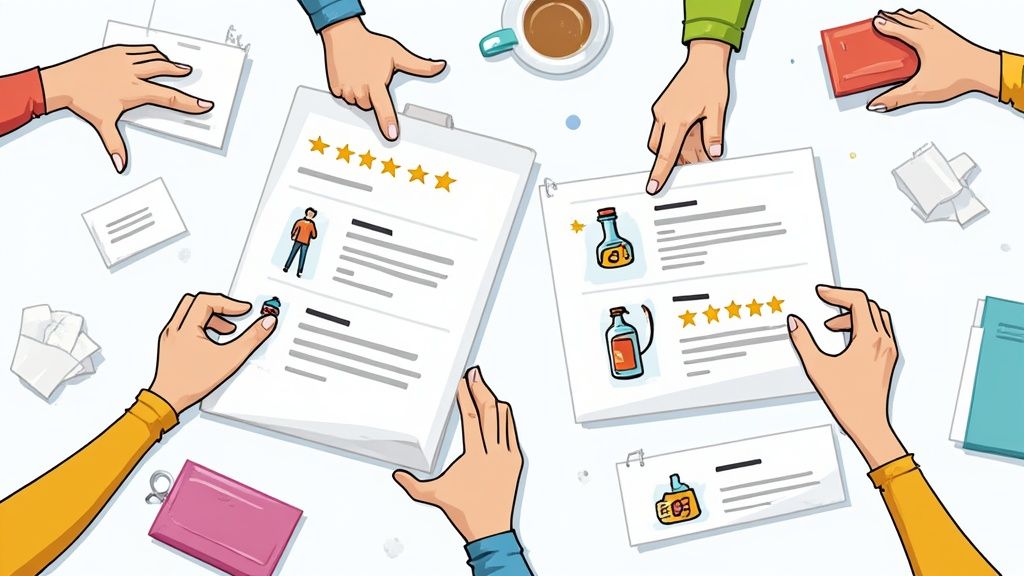
Here's a hard truth: your Shopify store is a data goldmine. Every click, search, and sale tells a story about what people want and where your business is falling short. If you want sustainable growth, you have to stop guessing and start listening to what that data is telling you.
Making data-driven decisions simply means swapping your assumptions for hard facts. This isn't about chasing the latest trend; it's about digging into your own performance data to find real opportunities to improve ecommerce sales. It’s time to get methodical with tools like Google Analytics 4 and Shopify's own analytics to unearth insights that actually move the needle.
Key Metrics That Actually Matter
It’s incredibly easy to drown in data. The trick is knowing which numbers to watch. Forget vanity metrics like social media likes—they feel good, but they don't pay the bills. Instead, your dashboard should be built around these three powerhouses.
Customer Lifetime Value (CLV): This is the holy grail. It’s the total revenue you can expect from a single customer over their entire relationship with your store. If your CLV is climbing, you know your products and retention efforts are hitting the mark.
Customer Acquisition Cost (CAC): Simply put, how much does it cost you to get a new customer in the door? Your goal is to keep your CAC significantly lower than your CLV. If you don't, you're losing money on every new person you bring in.
Cart Abandonment Rate: What percentage of shoppers add items to their cart but bail before paying? A high rate is a massive red flag, often pointing to friction in your checkout or unexpected shipping costs.
These three metrics give you a powerful, high-level snapshot of your business health. By tracking them regularly, you'll see the real impact of your strategic tweaks, from marketing campaigns to site redesigns. To really master this, you need to fully embrace the mindset of Data-Driven Ecommerce: Unlock Growth With Smart Data Strategies.
Uncovering Insights with Funnel Analysis
One of the most powerful views in your analytics toolkit is the funnel analysis report. It’s a visual map of the customer journey, from landing on your site to completing a purchase, and it shows you exactly where people are getting stuck and leaving.
Let's say your funnel has four main steps: View Product > Add to Cart > Begin Checkout > Purchase. Your report might reveal that 90% of visitors who view a product never even add it to their cart. That's a huge leak. It tells you the problem is likely on your product pages—maybe the descriptions are weak, the photos are blurry, or the price isn't clear. Without this data, you'd just be guessing.
By analyzing your conversion funnel, you can stop fixing things that aren't broken and focus your resources on the exact points of friction that are costing you sales. It's like having a map that shows you exactly where the treasure is buried.
Using Cohort Analysis to Measure Campaign Value
So, did that big influencer campaign or flash sale actually bring in good customers, or just a bunch of one-and-done buyers? Cohort analysis gives you the answer. This report groups customers by when they made their first purchase (for example, the "Summer Sale" cohort) and then tracks their spending habits over time.
You can then compare the "Summer Sale" cohort to customers you acquired the month before. Did the sale group come back for a second purchase more often? Was their CLV higher after three months? This kind of analysis reveals the true, long-term value of your marketing efforts, helping you invest your budget where it really counts—attracting loyal, high-value customers.
The need to be efficient and data-savvy is only growing. By 2025, ecommerce is expected to make up 20.5% of all global retail sales, and that number is projected to hit 22.5% by 2028. Mastering your data is the only way to claim your piece of that ever-expanding pie.
Frequently Asked Questions
As you start putting the strategies from this guide into action—whether it’s fine-tuning your site design or building out a new subscription model—questions are bound to pop up. It’s only natural. You're diving into the details, and specific challenges will emerge.
This section tackles some of the most common questions we hear from store owners who are laser-focused on growth. Think of it as a quick-reference guide to keep your momentum going and help you make smarter decisions on the fly.
How Quickly Can I See Results From These Strategies?
This is a great question, and the honest answer is: it depends. Some of the changes we've covered can deliver results almost immediately, while others are more of a long game—an investment in your brand’s future.
Technical Conversion Rate Optimization (CRO) tweaks usually offer the fastest wins. Things like streamlining your checkout flow or boosting your site's loading speed directly remove friction for your customers. You could see a noticeable lift in your conversion rate in just a few weeks from these kinds of high-impact fixes.
On the other hand, strategies like AI-powered personalization or launching a full-blown subscription model are a slow burn. You'll probably see some initial spikes in engagement, but the real payoff in metrics like revenue and customer lifetime value (CLV) will become clear over three to six months. That's when you'll have enough data to see the patterns and refine your approach. For a deeper dive, check out our complete guide on how to increase ecommerce sales.
Which Strategy Gives the Best ROI on a Small Budget?
If you're working with a tight budget, your absolute best bet is to pour your energy into Conversion Rate Optimization (CRO). The beauty of CRO is that many of its most powerful tactics are either low-cost or completely free to implement, but they punch way above their weight in terms of returns.
You’re essentially making every dollar you've already spent on marketing work harder. Instead of paying for more traffic, you’re getting more of your existing visitors to actually buy something.
Here are a few high-ROI actions you can take right away:
- Rewrite product descriptions to be less about specs and more about the benefits your customer will experience.
- A/B test your call-to-action buttons. You'd be surprised how much of a difference a new color or a change in wording can make.
- Sprinkle in trust badges and customer reviews to ease any hesitation a shopper might have.
- Simplify your checkout form by ruthlessly cutting out any field that isn’t absolutely essential.
These changes mainly cost you time and focus, not a big financial investment, which makes CRO the perfect starting point for any store looking to grow efficiently.
Should I Focus on Acquiring New Customers or Retaining Existing Ones?
Ah, the classic ecommerce dilemma. While you absolutely need both to grow, the data consistently points to a clear winner for long-term, sustainable profit: retention.
It can cost up to five times more to attract a brand-new customer than it does to convince an existing one to buy from you again.
Happy, loyal customers are the bedrock of a healthy business. Strategies like launching a "subscribe and save" model or sending highly personalized email campaigns are built for retention. Loyal customers don't just make repeat purchases; they also tend to have a higher CLV and—critically—become your best brand advocates, referring new customers to you for free. Always start by making sure your post-purchase experience is amazing. It’s what gives people a reason to come back.
What Are the Most Important Metrics to Track for Sales Growth?
It’s easy to get fixated on your total revenue number, but the real story is in the metrics that reveal the why behind the what. Focusing on the right numbers helps you see the complete picture of your store's health and efficiency.
If you’re serious about growth, these are the three metrics you need to live and breathe:
- Conversion Rate: This is the percentage of your site visitors who complete a purchase. It’s the ultimate report card on how persuasive your store is.
- Average Order Value (AOV): This tells you how much, on average, a customer spends in a single transaction. Pushing this number up is one of the most direct ways to boost revenue without needing more traffic.
- Customer Lifetime Value (CLV): This is the total profit you expect to make from a customer over their entire relationship with your brand. When your CLV is climbing, you know your loyalty efforts are paying off.
Ready to turn these strategies into real-world results? The team at ECORN specializes in transforming Shopify stores with expert design, development, and conversion optimization. Let's build a plan that works for you. Start your project with us today!






